This Flying Colours post will be an unusual one – with very little mentioned about Flying Colours. Instead, it will be all about cruising for two weeks on a boat several feet longer than Flying Colours, but only half the width – called a “narrowboat”. Our cruise is on the Llangollen Canal in the English Midlands and NE Wales with our longtime friends, Tom and Linda Dixon from Boise.
(Remember, you can click on any photo to enlarge. Also don’t forget that the formatting of this blog post is better – everything lines up better – when you can read it online at www.ronf-flyingcolours.com – click on this link to go there. Also, if you’re logged into the post with your own userid, you can request an automatic update whenever a new blog post is put up – just click on the Subscribe link and enter your e-mail address. You cannot do this, though, if you’re logged in using the “friends” username.)
First, how did this unusual cruise come about? Well, way back in February I posed the question to Tom during one of our catch-up e-mail threads – “I don’t suppose you and Linda would like to try a narrowboat canal trip on some idyllic English countryside canal this fall, would you?” The next day Tom wrote back that they were interested, and that got the research going.

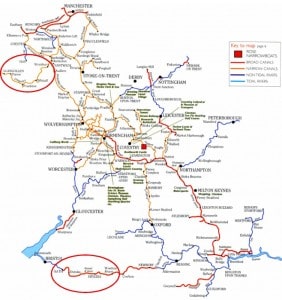 When you do an internet search on “U.K. narrowboat canal holidays” the number of hits is just overwhelming. Before you can even sift through the myriad boat hire companies, you first have to get an idea of which canal you want to cruise, and in which part of the U.K. There are 2,200 miles of navigable canals that are linked into a giant network extending throughout England and Wales – as you can see from the map at left. Where to begin the research????
When you do an internet search on “U.K. narrowboat canal holidays” the number of hits is just overwhelming. Before you can even sift through the myriad boat hire companies, you first have to get an idea of which canal you want to cruise, and in which part of the U.K. There are 2,200 miles of navigable canals that are linked into a giant network extending throughout England and Wales – as you can see from the map at left. Where to begin the research????
First – what is a narrowboat, and how did these amazing canals come about?
The U.K. canals pre-date railroads and car/trucks, and for three hundred years the canals and the barges that plied them were the freight haulers of the day. For whatever reason – most likely the cost of canal digging and construction, plus geography – the canals throughout the U.K. are quite narrow in many places . . . sometimes as narrow as 7’ . . . and the locks, tunnels, brick road bridges, and lift bridges are barely more than 7’ wide. As a result, the towed canal barges were typically 6’-6” in width – and hence the name, narrowboat. They were long, though, as long as 70’ in overall length, with all canal side structures capable of handling boats up to this length. Additionally, the canals were rather shallow – as shallow as 3’ – so the narrowboat hulls were designed with an 18” draft.
Second, in the early days the canals were mostly plied by barges that were towed by horse, donkey/mule, or pit ponies (so named because they were bred to pull carts in underground coal mines). When steam and diesel engines came into use, some of the towed barges were replaced (but not all – Kap and I toured a canal museum just outside Liverpool, and a couple who lived their entire lives on a freight-hauling barge still used a mule right up to their retirement in 1957).
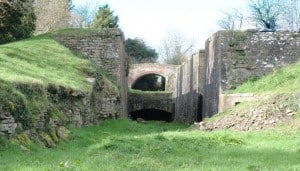 By the 1950s, many of the canals began to fall into serious disrepair as a result of railway and truck freight. England and Wales are still crisscrossed by thousands of miles of derelict canals, but luckily, about 2,000 miles have been restored to use for leisure cruising, thanks to the amazing work of the U.K. charity organization, the Canal & River Trust. As the photo at left shows, it isn’t just a matter of dredging out a muck-filled canal and running water through it again – but rather, includes restoration of “an enormous network of bridges, embankments, towpaths, aqueducts, docks and reservoirs alongside everything else that makes up our wonderful waterways.” The amazing part of this is, the result not only establishes a connection with a long-ago way of life that is hard to even imagine in today’s modern world, but it creates an incredible way for everyday people to enjoy it with self-drive holidays on these narrowboats.
By the 1950s, many of the canals began to fall into serious disrepair as a result of railway and truck freight. England and Wales are still crisscrossed by thousands of miles of derelict canals, but luckily, about 2,000 miles have been restored to use for leisure cruising, thanks to the amazing work of the U.K. charity organization, the Canal & River Trust. As the photo at left shows, it isn’t just a matter of dredging out a muck-filled canal and running water through it again – but rather, includes restoration of “an enormous network of bridges, embankments, towpaths, aqueducts, docks and reservoirs alongside everything else that makes up our wonderful waterways.” The amazing part of this is, the result not only establishes a connection with a long-ago way of life that is hard to even imagine in today’s modern world, but it creates an incredible way for everyday people to enjoy it with self-drive holidays on these narrowboats.
But back to our trip planning. Early on I stumbled onto a web site for the Kennet and Avon Canal (shown by the red circle at the bottom of the map above), described as “one of the loveliest waterways in Britain … meandering 86 miles between Bristol and Reading, passing through the historic city of Bath”. It intrigued me, as we’d be due west of London (close proximity to our arrival/departure at London’s Heathrow). And having never been to Bath, I thought it would be an interesting end point to explore. I poured over the online brochure and its description of possible cruise distances, mostly considering two week trips without a daunting number of locks. (Kap and I were on a 7-day French canal boat cruise in 2009 – on the Canal du Midi in Southern France – and except for a full day’s stop in Carcassonne to see the medieval fortress city, the 60+ locks completely dominated our cruise days. I was determined not to make that mistake again.) After lots of analysis and e-mail discussion with Tom and Linda, a “flight” of 29 stair step locks – called the Caen Hill Locks, that we’d have to do twice on this out-and-return cruise – nixed that canal choice from consideration, eating up two full days just on these locks. (Stair step locks are necessary where there is a larger-than-normal elevation change, and back-to-back locks “step” the canal boats up or down approximately 7’ in each lock. The elevation change at Caen Hill must be about 300’.)
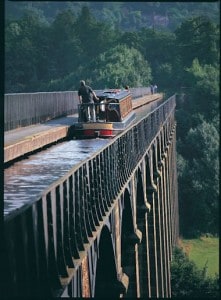
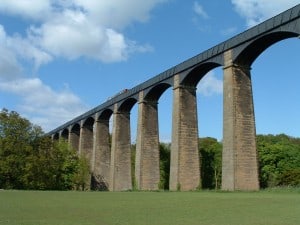 Then I spotted a link to the odd-sounding LLangollen Canal in Wales (at http://www.canalholidays.com/llangollen-canal.htm), starting with the description “considered the most beautiful waterway in the country . . . includes the famous Pontcysyllte Aqueduct, one of the wonders of the canals” – and a World Heritage Site. In a leisurely 54 mile out-and-return cruise, we’d have 12 locks in each direction, including three stair step locks. The description of the Pontcysyllte Aqueduct was what convinced me this was the canal for us – on approach to the Welsh mountains near our turnaround point at the small town of Llangollen, we’d cross a wide valley of the River Dee 126’ below us, in a cast iron trough just the width of the boat, supported by graceful stone and masonry piers. Coupled with the quarter mile long Chirk Tunnel (1,381’ to be exact), plus myriad bridges to pass through, I was quickly convinced this canal merited further research. Tom and Linda agreed.
Then I spotted a link to the odd-sounding LLangollen Canal in Wales (at http://www.canalholidays.com/llangollen-canal.htm), starting with the description “considered the most beautiful waterway in the country . . . includes the famous Pontcysyllte Aqueduct, one of the wonders of the canals” – and a World Heritage Site. In a leisurely 54 mile out-and-return cruise, we’d have 12 locks in each direction, including three stair step locks. The description of the Pontcysyllte Aqueduct was what convinced me this was the canal for us – on approach to the Welsh mountains near our turnaround point at the small town of Llangollen, we’d cross a wide valley of the River Dee 126’ below us, in a cast iron trough just the width of the boat, supported by graceful stone and masonry piers. Coupled with the quarter mile long Chirk Tunnel (1,381’ to be exact), plus myriad bridges to pass through, I was quickly convinced this canal merited further research. Tom and Linda agreed.
I next studied the Blue Waters Holidays website for boat bases, quickly settling on their Base 19 near the market town of Nantwich, in the English county of Cheshire and the old Roman city of Chester (straddling the Wales/England border, this cruise would wind in and out between the two U.K. countries multiple times).
![]() Next task was boat selection. With two couples in such tight quarters for two weeks, I felt that maximum space was best and settled on the Ashton Class boat – 66’ long, full galley with dinette, two cabins with either two singles or one double each, two toilets, and two showers. Again, Tom and Linda agreed on this, and we settled on a layout with a double bed cabin for them and Kap and I chose two twin singles, as we’d learned from the France cruise that a double was too small (little did we know just how small a narrowboat can really be).
Next task was boat selection. With two couples in such tight quarters for two weeks, I felt that maximum space was best and settled on the Ashton Class boat – 66’ long, full galley with dinette, two cabins with either two singles or one double each, two toilets, and two showers. Again, Tom and Linda agreed on this, and we settled on a layout with a double bed cabin for them and Kap and I chose two twin singles, as we’d learned from the France cruise that a double was too small (little did we know just how small a narrowboat can really be).
Once the basics were decided, the rest was just details – paying a deposit on the cruise, booking trans-Atlantic flights, car rental to get to/from LHR and the canal base, and the necessary hotel rooms before and after the actual cruise. And, of course, digging through as much literature as we could find on how to actually do a U.K. canal cruise, including daily cruise plans, where we’d eat, and such mundane things.
So, just where is the Llangollen Canal? Well, in the big picture, it’s on the NW border of England and NE border of Wales, just below 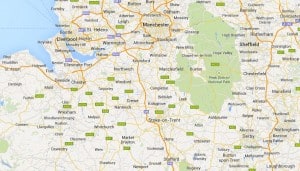
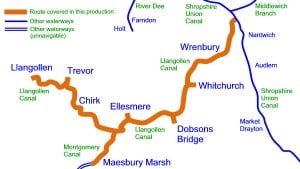 Liverpool and Manchester. On the Google Map, the canal (not marked) is in the lower left quadrant, and you can locate Liverpool and Manchester to the north. In the large scale map that shows the canal in orange, our plan was to cruise out-and-return on the section from the tiny village of Wrenbury at the upper right, to Llangollen at the upper left (with a side trip on the Montgomery Canal to Maesbury Marsh at the bottom.
Liverpool and Manchester. On the Google Map, the canal (not marked) is in the lower left quadrant, and you can locate Liverpool and Manchester to the north. In the large scale map that shows the canal in orange, our plan was to cruise out-and-return on the section from the tiny village of Wrenbury at the upper right, to Llangollen at the upper left (with a side trip on the Montgomery Canal to Maesbury Marsh at the bottom.
Tuesday, September 16, 2014, Across The Pond. Given that my United Airlines frequent flyer account has a gazillion miles in it, we decided to fly First Class to London. There are several route options, and we chose Seattle (SEA) – San Francisco (SFO) – London (LHR) in both directions, with B757 service between SEA and SFO, then B777 service on the Trans-Atlantic segments.
Our SEA to SFO flight, with an 8:30AM departure and 10:50AM arrival, gave us a first. On deplaning at SFO, we were met at the aircraft cabin door by a UAL representative holding a name board that had my name and Kap’s name written out on it. My heart sank, as it instantly spelled trouble of some kind.
“What’s up,” I asked. “Something wrong?”
“No, nothing wrong . . . I have a Mercedes waiting below to take you to your London flight,” she responded.
At that, we descended the outside stairs from the jetway and onto the tarmac below. Twenty feet away was a large Mercedes SUV with a livery uniformed driver waiting at the back to stow our hand baggage. Once inside, our UAL lady guide introduced herself as a United Global Services representative, and she was taking us directly across to our waiting aircraft – but since we had plenty of connection time she’d first take us to the Global First Class lounge.
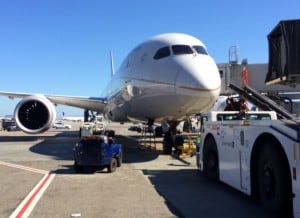 It’s not every day one gets to weave through commercial jetliners sitting at their gates. Since we were heading for the international terminal, there were two or three B747 tails that we drove under, another two or three B777 tails, and one brand spanking new United B787 Dreamliner (that’s it at left).
It’s not every day one gets to weave through commercial jetliners sitting at their gates. Since we were heading for the international terminal, there were two or three B747 tails that we drove under, another two or three B777 tails, and one brand spanking new United B787 Dreamliner (that’s it at left).
The best part of this was, getting from the United domestic terminal to their international departure gates typically requires passing again through TSA security, which is still a hassle even though we’re part of the TSA Pre-Check program (the fast-access program that has short lines, no requirement for 3 oz liquid containers to be in a Ziploc bag, and laptops stay in your carry-on). So, with that service, and within 10 minutes of getting off our SEA-SFO flight, we were comfortably seated in the United Global First Class Lounge just a few feet from our London departure gate. What a deal!
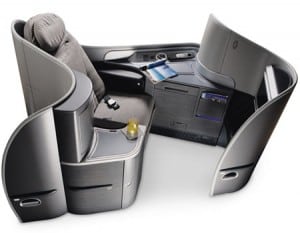 International First Class is always a pleasure, ensconced in what United calls their Global First Suites – a complicated affair that’s large and thoroughly outfitted with every comfort (you push a button on the center console and as the seat bottom slides all the way forward, the seat back lays down to make into a 6’3” flat bed) . Nevertheless, it was a long, overnight flight, with a very so-so dinner served shortly after take-off, and an even more so-so warmed-over breakfast served just before landing. In between was a fitful night of sleep, but it was still better than in the seats in the back of the airplane.
International First Class is always a pleasure, ensconced in what United calls their Global First Suites – a complicated affair that’s large and thoroughly outfitted with every comfort (you push a button on the center console and as the seat bottom slides all the way forward, the seat back lays down to make into a 6’3” flat bed) . Nevertheless, it was a long, overnight flight, with a very so-so dinner served shortly after take-off, and an even more so-so warmed-over breakfast served just before landing. In between was a fitful night of sleep, but it was still better than in the seats in the back of the airplane.
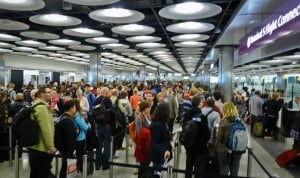 Our arrival at LHR was on time at 7AM, and Kap and I were the first two passengers off the plane. It always seems like a mile’s walk to Passport Control, winding down this walkway, then another, then up this escalator, down another one, and finally into the huge Passport Control hall.
Our arrival at LHR was on time at 7AM, and Kap and I were the first two passengers off the plane. It always seems like a mile’s walk to Passport Control, winding down this walkway, then another, then up this escalator, down another one, and finally into the huge Passport Control hall.
One huge advantage to First or Business Class is getting a Fast Track card to use at Passport Control on arrival, where Kap and I were second in line (as opposed to being 200th in line as in the sample image at left that I grabbed from the internet), getting us to the baggage area within a few minutes of deplaning. By 7:30AM, we were through the formalities and standing in line for the morning’s first latte at a Café Nero coffee counter in the newly renovated Terminal 2 (until earlier this year, United had used Terminal 3 since it bought the Pan Am London routes many years ago – and being brand new, this was a welcome change).
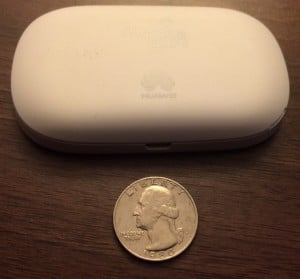 With a latte in hand, we headed straight for the nearest cell phone kiosk in the terminal (due to excessive roaming rates, almost every European traveler buys a cell phone or SIM card the moment they arrive in London). My hope was to purchase a U.K. SIM card that could give us WiFi access through my Telus broadband gizmo that I’d purchased a couple of months earlier in Sidney (B.C.) and used aboard Flying Colours (that would have a data plan much cheaper than with either a U.S. or Canadian SIM card). We quickly located a kiosk, but unfortunately, the young woman working it was totally unknowledgeable about what I needed and directed us to their other kiosk in Terminal 1. It was a long hoof, pushing a heavy luggage cart through the subterranean walkways of the LHR terminals, but we got there alive and well. Sure enough, the guy knew what I wanted, and within a half hour he configured it for me and we were on our way. As you can see in the photo, the gizmo is about ½ the size of a bar of soap, and attaches to my PC with a USB cable. (I hoped it would be a communications lifesaver for us on the canal boat, but it wasn’t – after trying it several times on the first two days on the boat and getting nowhere, it went into my suitcase and never saw the light of day again.)
With a latte in hand, we headed straight for the nearest cell phone kiosk in the terminal (due to excessive roaming rates, almost every European traveler buys a cell phone or SIM card the moment they arrive in London). My hope was to purchase a U.K. SIM card that could give us WiFi access through my Telus broadband gizmo that I’d purchased a couple of months earlier in Sidney (B.C.) and used aboard Flying Colours (that would have a data plan much cheaper than with either a U.S. or Canadian SIM card). We quickly located a kiosk, but unfortunately, the young woman working it was totally unknowledgeable about what I needed and directed us to their other kiosk in Terminal 1. It was a long hoof, pushing a heavy luggage cart through the subterranean walkways of the LHR terminals, but we got there alive and well. Sure enough, the guy knew what I wanted, and within a half hour he configured it for me and we were on our way. As you can see in the photo, the gizmo is about ½ the size of a bar of soap, and attaches to my PC with a USB cable. (I hoped it would be a communications lifesaver for us on the canal boat, but it wasn’t – after trying it several times on the first two days on the boat and getting nowhere, it went into my suitcase and never saw the light of day again.)
Next stop was a rental car pickup along the airport perimeter road. For flexibility I had rented from Europcar, booking it for the full two-week duration of our canal cruise, with the plan to drive it to the canal departure point, leave it there during our cruise, then drive it back to London at the cruise end. We have lots of experience driving right-hand cars on the left side of the road, so it was no problem – but our rule is, the person not driving is always alert to ensure the driver doesn’t do something stupid (like pull out of a parking lot and automatically head for the wrong side of the road). For that, Kap has a good rule – the steering wheel side of the car is always next to the center lane, so that mantra helps keep us out of trouble.
GPS. One more pre-arrival detail to mention. Our trusty Magellan Roadmate GPS that saved our bacon on several earlier European trips was big and bulky, and getting long in the tooth compared to today’s handheld units. We kicked around the idea of just using the Google Maps road directions on my iPhone or our iPads (we have Kap’s iPad Air and my iPad mini with us), but experience has shown that any lapse in cell coverage wipes out your turn-by-turn directions. We opted to get a small Garmin car GPS before we left home, purchased the U.K. maps to download, and it’s worked beautifully on the trip. One of the best new features with it is specific lane guidance, which has paid for itself many times over on motorway interchanges and complex roundabouts.
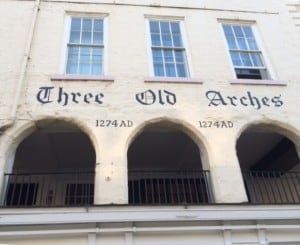 Pre-canal cruise time in Chester. The 3-hour drive from LHR to Chester was hectic and tiring, mainly due to very heavy traffic, and a surprising amount of road construction. I had booked a 3-night room for us at the Chester Hilton Doubletree Hotel on the eastern side of Chester. We’ve never been to Chester before, and frankly, knew absolutely nothing about this city of 328,000 people (to be honest, I thought it was a city of maybe 50,000 at most). As we soon learned, Chester is an old walled Roman fortress city, founded in the year 79, making it almost 2,000 years old! It was part of the Roman Empire for three hundred years, and to this day is one of the best-preserved walled cities in Britain. (I snapped the photo above from our sidewalk dining table on Chester’s walking street, first amazed that the building housing the restaurant was built in 1274, but then even more amazed when it dawned on me that the city was already well over 1,000 years old at the time this was built.)
Pre-canal cruise time in Chester. The 3-hour drive from LHR to Chester was hectic and tiring, mainly due to very heavy traffic, and a surprising amount of road construction. I had booked a 3-night room for us at the Chester Hilton Doubletree Hotel on the eastern side of Chester. We’ve never been to Chester before, and frankly, knew absolutely nothing about this city of 328,000 people (to be honest, I thought it was a city of maybe 50,000 at most). As we soon learned, Chester is an old walled Roman fortress city, founded in the year 79, making it almost 2,000 years old! It was part of the Roman Empire for three hundred years, and to this day is one of the best-preserved walled cities in Britain. (I snapped the photo above from our sidewalk dining table on Chester’s walking street, first amazed that the building housing the restaurant was built in 1274, but then even more amazed when it dawned on me that the city was already well over 1,000 years old at the time this was built.)
As usual, Kap poured over the various tourist books we had with us, and the next day we set out to visit the National Waterways Museum at Ellesmere Port on the south side of Liverpool. Since we’d be boarding our canal narrowboat in two days’ time, the combination indoor/outdoor museum that incorporated real working canal locks with examples of canal barges in operation was very interesting. Even though we watched as a canal boat was being taken through three stair step locks, we didn’t have a clue what we were looking at or how they operated.
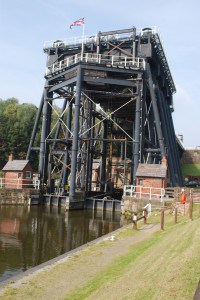 Later in the day, Kap steered us to another engineering wonder of the canal days – the Anderton Boat Lift – a five-story tall iron spider-looking thing, built in 1875, and created to raise canal boats 50’ from the River Weaver to the Trent & Mersey Canal. The lift was in continuous operation until 1983 when structural deficiencies were detected. A restoration to correct the problems was completed in 2002, and the boat lift now operates only to give a lift up and down 3-times a day to a tourist boat.
Later in the day, Kap steered us to another engineering wonder of the canal days – the Anderton Boat Lift – a five-story tall iron spider-looking thing, built in 1875, and created to raise canal boats 50’ from the River Weaver to the Trent & Mersey Canal. The lift was in continuous operation until 1983 when structural deficiencies were detected. A restoration to correct the problems was completed in 2002, and the boat lift now operates only to give a lift up and down 3-times a day to a tourist boat.
In the photo at left, I’m obviously standing at the bottom of the lift, with the River Mersey passing behind me (the water leading into the lift is a small arm from the river to the lift). On either side of the tall circular column is a canal boat “tub”, each one holding a single narrowboat. The tubs act as counterweights, raising one boat in one tub as it’s lowering another boat in the opposite tub, so there would always be one tub at the top and one at the bottom. When ready to lift/lower two narrowboat barges filled with goods, a small amount of water in the lower tub is drained, and the higher weight of the upper tub lowers it as it raises the other. 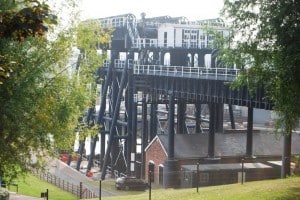 In the next photo I’m standing on a grassy berm, at eye level with the upper canal. Just inside the white fence is an aqueduct that a narrowboat drives into or out of to the Trent & Mersey Canal to the right of where I’m standing.
In the next photo I’m standing on a grassy berm, at eye level with the upper canal. Just inside the white fence is an aqueduct that a narrowboat drives into or out of to the Trent & Mersey Canal to the right of where I’m standing.
While exceedingly complicated by the engineering standards of the day, the use of a lifting mechanism eliminated the need for 7-8 stair step locks, plus the resulting water loss (there wasn’t a good source of nearby water to serve the locks).
And you might be asking, what was the great industrial or economic purpose of canals in this area that warranted such incredible feats of engineering, and at such cost? The answer: salt. The following is quoted from the Wikipedia article on the Anderton Boat Lift: “Salt has been extracted from rock salt beds underneath the Cheshire Plain since Roman times. By the end of the 17th century a major salt mining industry had developed around the Cheshire “salt towns” of Northwich, Middlewich, Nantwich and Winsford.” (The “wich” suffix in these Cheshire town names means they are associated with salt, which we learned while having lunch in Nantwich and I asked the shopkeeper about it. A more complete discussion of it can be found in the Wikipedia article on “-wich towns”, at http://en.wikipedia.org/wiki/-wich_town.)
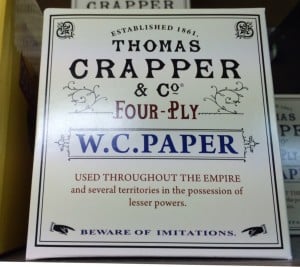 Speaking of Nantwich, on the day we first met up with Tom and Linda we had lunch in the town square. While perusing a very nice deli to see if it had anything we might need on the narrowboat, I spied an item on the shelf that is uniquely British – and fitting for the country that invented the indoor flush toilet – a roll of toilet paper branded by the very man who is thought to have invented the WC – one Thomas Crapper. Whether the invention claim is valid or not, he was a plumber in London who founded the company, Thomas Crapper & Co, and with his invention of the ballcock, he did indeed make the flush toilet considerably more popular.
Speaking of Nantwich, on the day we first met up with Tom and Linda we had lunch in the town square. While perusing a very nice deli to see if it had anything we might need on the narrowboat, I spied an item on the shelf that is uniquely British – and fitting for the country that invented the indoor flush toilet – a roll of toilet paper branded by the very man who is thought to have invented the WC – one Thomas Crapper. Whether the invention claim is valid or not, he was a plumber in London who founded the company, Thomas Crapper & Co, and with his invention of the ballcock, he did indeed make the flush toilet considerably more popular.
Saturday, September 20th, 2014 – Narrowboat Pickup Day. The big event for the day is to have a quick look at our narrowboat “home” for the next two weeks, and then head to the nearest supermarket for some provisioning.
Our boat base is in the tiny village of Wrenbury Mill, about five miles SW of Nantwich (and about 30 miles SE of Chester). Not as old as Chester, but nevertheless listed in the Domesday Book (completed in 1086), with a population of 1,100. It boasts two pubs, a convenience store that carries food stuffs similar to what you’d find in a 7-Eleven, a 500 year old Anglican Church, a post office, a doctor’s surgery, and of course the Alvechurch Boat Centre.
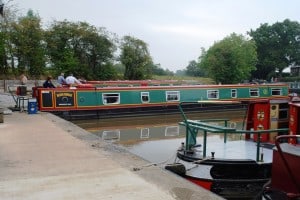 When we arrived, our boat wasn’t yet returned from the current renters, but we got a glimpse of what it would look like – from her Aston class sister boat, the Bean Goose, sitting at the dock. We couldn’t board her to have a look around as the next hire group was readying to depart, but we got a good briefing of our accommodations – enough for us to set off provisioning. We also got to see just how long 66’ is, and it definitely gave us pause.
When we arrived, our boat wasn’t yet returned from the current renters, but we got a glimpse of what it would look like – from her Aston class sister boat, the Bean Goose, sitting at the dock. We couldn’t board her to have a look around as the next hire group was readying to depart, but we got a good briefing of our accommodations – enough for us to set off provisioning. We also got to see just how long 66’ is, and it definitely gave us pause.
A main part of our plan was not to cook any more meals on board than absolutely necessary, particularly evening meals – but rather, to eat at local pubs whenever possible, and to get off the boat as often as possible to explore the countryside and nearby villages. This was to be a leisure holiday, leaving day-to-day chores like cooking at home. We’d have breakfast on the boat, but mostly just cereals, toast, and yoghurt with berries. For lunch, we’d stock up on sandwich fixings and instant soups.
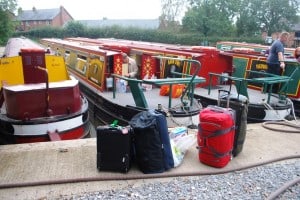 At 4PM we returned with a half dozen shopping bags and our luggage, ready to board our now-ready Yellow Legged Gull awaiting us at the dock. After everything was loaded, we were ready for our boat briefing and we’d be off.
At 4PM we returned with a half dozen shopping bags and our luggage, ready to board our now-ready Yellow Legged Gull awaiting us at the dock. After everything was loaded, we were ready for our boat briefing and we’d be off.
The briefing was from bow to stern, including how to fill fresh water tanks (recommended every day at filling points found along the canals), how/where/when to pump out the black water tanks (one for each head, and we eventually pumped out twice during our two week cruise), how to operate the diesel heating system, cautions on what not to put down the electric toilets (“nothing that we haven’t eaten”), all about operation of the boat’s diesel engine, and instructions on how the tiller/rudder works. It all took a bit less than an hour . . . and we were ready to go.
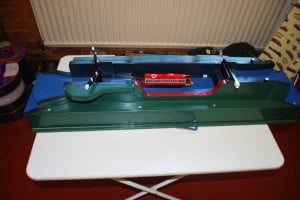 We also had a shore briefing of important things along our canal route – particularly how to operate the locks. Our first lock was at least five miles down the canal from our begin point, and in all likelihood we’d be alone to operate it. The boat hire place had a small scale model (about 3’ in length, shown at left) of a typical lock, and we got about a 10 minute briefing on how to open and close the lock doors, raise and lower the water level, and the various “rules of the road” concerning who has right of way when two boats approach the lock from opposite directions, and how to leave the lock if you see someone approaching as we depart. The concepts were all easy enough, but I must confess that many of the details of the actual lock mechanisms weren’t clear to me. Luckily, Kap took charge of our first lock, and that’s good, as her spatial and mechanical abilities are superb.
We also had a shore briefing of important things along our canal route – particularly how to operate the locks. Our first lock was at least five miles down the canal from our begin point, and in all likelihood we’d be alone to operate it. The boat hire place had a small scale model (about 3’ in length, shown at left) of a typical lock, and we got about a 10 minute briefing on how to open and close the lock doors, raise and lower the water level, and the various “rules of the road” concerning who has right of way when two boats approach the lock from opposite directions, and how to leave the lock if you see someone approaching as we depart. The concepts were all easy enough, but I must confess that many of the details of the actual lock mechanisms weren’t clear to me. Luckily, Kap took charge of our first lock, and that’s good, as her spatial and mechanical abilities are superb.
When we were ready to go, our boat yard mechanic steered the boat out of the basin, as it required a tricky 90° to enter the canal, then to head immediately through the narrow confines of a lift bridge – and that was definitely beyond our skill level to start with. Once through the bridge, the tiller was handed over to Kap, as she was designated to be our first Captain of the cruise. She drove well enough that the mechanic hopped off on the shore within a ¼ mile, and we were on our own. Kap stayed at the tiller until our first night’s stop – and managed not to hit anything or sink us.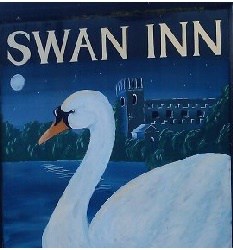
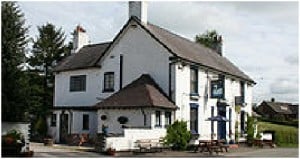 Given the late hour of our departure (5PM), we didn’t have a long cruise planned for this first day . . . but hopefully far enough down the canal to get the hang of things, and maybe tie up along the bank near the first pub we came to.
Given the late hour of our departure (5PM), we didn’t have a long cruise planned for this first day . . . but hopefully far enough down the canal to get the hang of things, and maybe tie up along the bank near the first pub we came to.
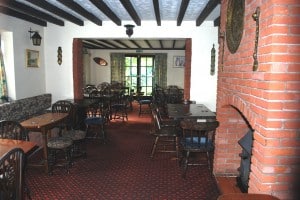 Our pub guide identified the first pub as The Swan Inn, in the tiny village of Marbury, and supposedly ½ mile walk up the Hollyhurst Road from the bridge where we’d left the boat (it was, in fact, easily a mile). The pub notes mentioned, “This classic old English farmhouse pub, licensed as far back as the 1750’s, is now an excellent destination food house, retaining traditional public house atmosphere, in the centre of the beautiful village of Marbury, right on the village green.” It was our first taste of pub food for this trip, and it certainly wasn’t our last.
Our pub guide identified the first pub as The Swan Inn, in the tiny village of Marbury, and supposedly ½ mile walk up the Hollyhurst Road from the bridge where we’d left the boat (it was, in fact, easily a mile). The pub notes mentioned, “This classic old English farmhouse pub, licensed as far back as the 1750’s, is now an excellent destination food house, retaining traditional public house atmosphere, in the centre of the beautiful village of Marbury, right on the village green.” It was our first taste of pub food for this trip, and it certainly wasn’t our last.
Eating in pubs. English pubs bear a bit of description. Throughout the U.K., the concept of restaurants is very different than in America. Most towns and villages, particularly the smaller ones, don’t have restaurants as we think of them (i.e., nothing like a T.G.I. Friday’s, or a Red Robin; no McDonalds, no KFC, no Subway, nothing whatsoever like that). Instead, even a village of 50 people will have a pub, and many very small towns will have two pubs. The Swan Inn pictured above is a very common style of pub – with a second floor that has two or three rooms for the overnight traveler, a proper bar with at least a half dozen beer pulls, a back bar for spirits, and ample tables for dining in adjoining rooms. If you’re at the pub for dinner, standard procedure in most places is to first find a table, then go to the bar to order a pint of beer or glass of wine, taking a menu back to the table with you. Once the menu is consulted, you then go back to the bar to order (and pay in advance), pointing out where your table is (or give them the table number). The food is then brought to you when it’s ready. More and more pubs now have a wait staff to take your order at the table, possibly because that’s how it’s done in the movies or they’ve seen it in other countries.
Pub food is quite standard, and typically includes all of the English favorites – steak and ale pie, sausage and mash in a Yorkshire pudding, fish and chips, gammon (ham steak) with fries and peas, and one or two cuts of steak with peppercorn sauce or other sauce. The food is usually OK, but not top notch, and after a few days of various pubs it becomes monotonous and you yearn for the variety of American restaurants. We never once saw some of the more famous British oddities, such as Toad In The Hole, Spotted Dick, or Bubble & Squeak.
Our first night on the Yellow Legged Gull. Dinner at the local pub always took longer than we expected, and walking back to the boat every night was in the dark. This first night, we were lucky that everyone had a flashlight (or headlamp) of some kind, as the pub was more like a mile from the boat, it was a dark, overcast night, and the lane to the canal had lots of animal manure about.
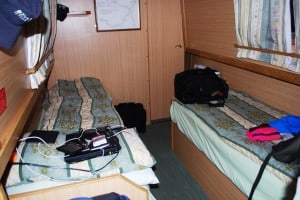 Needless to say, the first night was a miserable sleep for both Kap and I. Our single beds were on opposite sides of our tiny stateroom (if you can call it that, and it was also the hallway between Tom and Linda’s stateroom and the rest of the boat). Our mattresses were broken-down affairs, and I spent most of the night trying my best not to fall to the floor from the middle section at my butt where it sagged horribly. In the morning we were ready to call the boat basin to have a new mattress for each of us delivered, but decided against it when we figured out that turning the mattresses over made the situation tolerable. Coupled with just how narrow these boats are for getting around and being comfortable, it was not an auspicious beginning.
Needless to say, the first night was a miserable sleep for both Kap and I. Our single beds were on opposite sides of our tiny stateroom (if you can call it that, and it was also the hallway between Tom and Linda’s stateroom and the rest of the boat). Our mattresses were broken-down affairs, and I spent most of the night trying my best not to fall to the floor from the middle section at my butt where it sagged horribly. In the morning we were ready to call the boat basin to have a new mattress for each of us delivered, but decided against it when we figured out that turning the mattresses over made the situation tolerable. Coupled with just how narrow these boats are for getting around and being comfortable, it was not an auspicious beginning.
Tom and Linda didn’t fare much better, as a hot water bottle that Linda took to bed to sooth an aching neck pain leaked, soaking their bed and duvet. It reminded me of the Pink Panther scene where Inspector Clouseau popped the cork on a champagne bottle in bed and under the blankets.
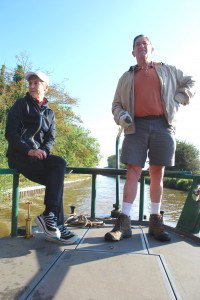 In the morning, an instant latte (nothing like Starbucks, and it would be a full two weeks before we’d see our next Starbucks), some toast and marmalade, and the camaraderie between the four of us made it all better.
In the morning, an instant latte (nothing like Starbucks, and it would be a full two weeks before we’d see our next Starbucks), some toast and marmalade, and the camaraderie between the four of us made it all better.
Sunday, September 21, 2014, Marbury to Whitchurch. Today was declared to be Tom’s day as boat Captain – which ostensibly gave him the authority to choose when we’d stop for the day (although, it really was a 4-way decision) . . . and of course, he got to drive.
Knowing that we were on an out-and-return trip that can be done in a week – and we had a full two weeks to do it in – we were not in any hurry to get anywhere. The distance traveled was barely eight miles, but it had our biggest concentration of locks on the entire route – a total of 10 locks, three of which were stair step locks as we rounded the sweeping curve to Grindley Brook on the north side of Whitchurch.
Drive on the left, drive on the right – which will it be? Remember, this is the U.K., where cars have right hand drive and the lane you drive in is on the left. So, on a canal narrowboat, where you stand at the rear and steer with a tiller/rudder in the center of the boat, which side of the canal do you drive on, and which side do you pass an oncoming boat?
Well, it was surprisingly (at least to us). U.K. canals are more narrow than anywhere on the Continent, and oftentimes there are weeds growing from the bank and out into the canal – in some places a surprising amount. Further, the canals shallow up along the sides – often to less than 18”, which is a narrowboat draft – so it’s advisable to steer as much as possible in the center of the canal. It also gives a slight advantage to the driver on approach to a corner, as they are typically blind due to the high growth along the bank, and even though we were only traveling at 2-3 MPH, you really have to keep in mind that the bow is 66’ in front of you, and it takes quite a long time to change its direction of travel.
So, which side do you pass on? Well, the protocol is to pass port to port (i.e., on the right) . . . or opposite what you do on a British highway or street. Go figure.
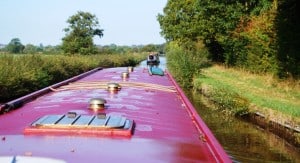 In the photo at left, you can see that Tom is driving right down the middle as he approaches the oncoming narrowboat – and so is the driver of that oncoming boat. More importantly, with uncut weeds/shrubs growing out from both sides of the canal, the waterway has narrowed down considerably, to the point where one or both boats will have to hug the canal side to safely pass. Etiquette is also to slow down when meeting boats, and it’s typical that a pleasant exchange, nod of the head, and a small wave between drivers and passengers is done – all very British, all very polite, and all very friendly.
In the photo at left, you can see that Tom is driving right down the middle as he approaches the oncoming narrowboat – and so is the driver of that oncoming boat. More importantly, with uncut weeds/shrubs growing out from both sides of the canal, the waterway has narrowed down considerably, to the point where one or both boats will have to hug the canal side to safely pass. Etiquette is also to slow down when meeting boats, and it’s typical that a pleasant exchange, nod of the head, and a small wave between drivers and passengers is done – all very British, all very polite, and all very friendly.
Transiting tunnels. Along the way we transited six tunnels in each direction, some as short as 50’, and the longest being ¼ mile long. Invariably, one entrance or the other was at a sharp bend in the canal, making the entrance almost blind. Not long after we got started, we decided it would be a good idea to have at least one person at the bow at all times, giving an extra 66’ notice to the narrowboat driver that something significant was ahead – another narrowboat coming around a steep canal bend, or a hidden bridge or tunnel at a curve.
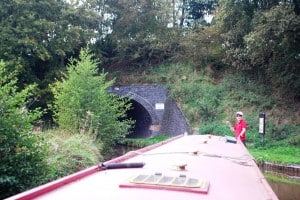 In photo #1 of the tunnel sequence, Kap is letting Tom know that a hidden tunnel at the beginning of the Grindley Bridge Locks is fast approaching. By this time, the boat had better be at dead slow, or it will be impossible to negotiate the sharp curve.
In photo #1 of the tunnel sequence, Kap is letting Tom know that a hidden tunnel at the beginning of the Grindley Bridge Locks is fast approaching. By this time, the boat had better be at dead slow, or it will be impossible to negotiate the sharp curve.
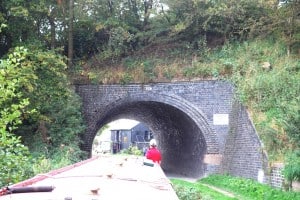 In photo #2, the curve has been made, but now the task is to get the narrowboat perfectly lined up for the bow to make the tunnel entrance – where there is a scant 6-8” of clearance with the stone side rails. The tunnel width is deceiving, as it has the original towpath just off Kap’s right side, so gauging the clearance requires the driver to lean out in both directions to line up.
In photo #2, the curve has been made, but now the task is to get the narrowboat perfectly lined up for the bow to make the tunnel entrance – where there is a scant 6-8” of clearance with the stone side rails. The tunnel width is deceiving, as it has the original towpath just off Kap’s right side, so gauging the clearance requires the driver to lean out in both directions to line up.
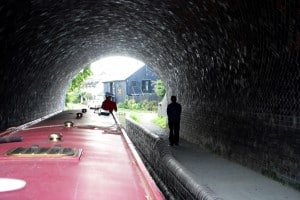 Once inside the tunnel (photo #3), it actually becomes easier, as the boat has nowhere else to go but through the tunnel, often gently brushing the tunnel side rails to keep it going straight.
Once inside the tunnel (photo #3), it actually becomes easier, as the boat has nowhere else to go but through the tunnel, often gently brushing the tunnel side rails to keep it going straight.
It’s hard to see in photo #3, but there is a cream-colored Mercedes sedan directly ahead of the boat’s bow, and that’s a good indication the canal makes a sharp jog to the left immediately after exiting the tunnel. All of these telltale signs have to be carefully watched by the driver; otherwise things catch up with you and before you know it, you’ve banged hard into something.
Stair step locks. Most canal locks are single, providing for an elevation change of up to 7’ in a single lock. On the U.K. canal system, single locks are “self-service”, meaning that each boat’s crew works all of the lock mechanisms, while the boat driver remains on board the boat to drive it through. For elevation changes greater than 7’ (or so), a staircase lock is typically built, and because they are significantly more complex, a lockkeeper is on duty to oversee the lock operation. The complexity is due to these factors: (1) multiple boats may be in the various step locks at one time, and management of this is critical; and (2) efficient water usage must be maintained, as the water valves and lock doors for the various step locks must be opened/closed in proper sequence for lock operation to work. Even with a lockkeeper, it’s fairly complex if really good spatial ability isn’t maintained (I typically relied on the lockkeeper to tell me what to do, rather than do stupid things on my own).
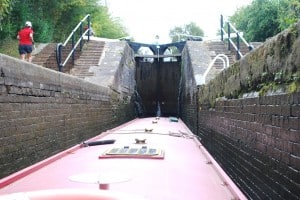 In the photo at left, we’ve entered the lower chamber of the stair step Grindley Locks (i.e., we’re being “stepped up” to a higher canal level, and the chamber we’ve just entered is drained (except for enough water to float us). Kap is running up the side steps, windlass crank in hand, to assist with opening the water valve above so that our lock chamber can be filled. There is a boat in the lock chamber directly in front of us – you can just see the boat’s driver above the doors at the head of our lock. As soon as that boat exits his lock and the lock doors close behind him, Kap (on one side), and the lockkeeper (on the other side) will crank the water valves on the lock doors open, flooding our lock and floating us up to the level where you now see the boat in front of us.
In the photo at left, we’ve entered the lower chamber of the stair step Grindley Locks (i.e., we’re being “stepped up” to a higher canal level, and the chamber we’ve just entered is drained (except for enough water to float us). Kap is running up the side steps, windlass crank in hand, to assist with opening the water valve above so that our lock chamber can be filled. There is a boat in the lock chamber directly in front of us – you can just see the boat’s driver above the doors at the head of our lock. As soon as that boat exits his lock and the lock doors close behind him, Kap (on one side), and the lockkeeper (on the other side) will crank the water valves on the lock doors open, flooding our lock and floating us up to the level where you now see the boat in front of us.
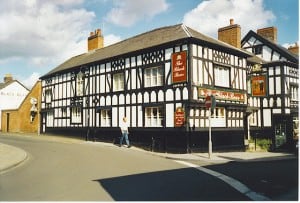 Visiting Whitchurch. Whitchurch is one of the two largest towns we’d pass through on this cruise (population around 8,000), so we wanted to explore it a bit, as well as have dinner. It’s another of the towns in the area founded by the Romans – around 52AD
Visiting Whitchurch. Whitchurch is one of the two largest towns we’d pass through on this cruise (population around 8,000), so we wanted to explore it a bit, as well as have dinner. It’s another of the towns in the area founded by the Romans – around 52AD
Unfortunately, the canal builders originally planned to bypass Whitchurch altogether, and even though those plans changed, it’s a fairly long walk to the town center. After walking for what seemed an eternity, we stopped in a small grocery store to get advice on a good pub for dinner, completely forgetting the day was Sunday, and our choices were going to be slim. Turns out, the further walk to the recommended Black Bear Pub (pictured above) was another mile, and lucky for us, a guy in the checkout line who overheard our conversation stopped to pick us up with his Land Rover. As usual, the menu included steak and ale pie, a chicken fillet in a curry sauce, a ham steak (called Gammon Steak in the U.K.), a fish dish of smoked haddock and prawns, the standard lamb dish, and a roast duck leg (none of which I was hungry for, so I settled for a Black Bear steak burger). I was also getting my quota of Guinness beer pints (if it wasn’t for Guinness, I wouldn’t drink beer, as it’s silky smooth, without the bitterness of other beers).
Given the distance we’d walked to get here, we planned to call a taxi, but that idea was nixed when we learned there are no taxis working on Sunday. In the dark, we walked a very long way back to the boat.
Monday, September 22, 2014, Whitchurch to Ellesmere. Today was our longest day so far, cruising slowly (never more than 2-3 knots), covering mile after mile, pressing on to arrive at Ellesmere just after 5PM. Had we chosen to, we could have stopped for the night at any spot along the route, but we wanted to spend a night at Ellesmere in any case, so a long day made sense. Unfortunately, the narrowboat hire basin we planned to stop at for a fresh water refill and black water pump-out was closed for the evening and wouldn’t be open the next day due to a power problem.
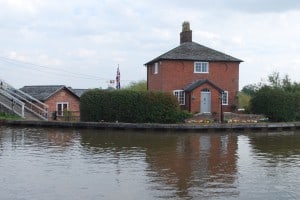 England-Wales border. By a quirk of geography (a pronounced bulge in the Wales border along our route), as well as the squiggly nature of the canal, we crossed the Welsh/English border multiple times on our cruise. Since both countries are part of the United Kingdom, though, the crossings were barely noticeable – in fact, just a small 4’ high milepost type of marker in one spot. For some reason that we could not explain, though, at the junction of the Llangollen Canal with the Shropshire Union Prees Branch canal was a prim and proper Customs House (shown in the photo at left). It almost certainly doesn’t serve as a border crossing house at this point, but there was no indication what it’s now used for – possibly a private residence.
England-Wales border. By a quirk of geography (a pronounced bulge in the Wales border along our route), as well as the squiggly nature of the canal, we crossed the Welsh/English border multiple times on our cruise. Since both countries are part of the United Kingdom, though, the crossings were barely noticeable – in fact, just a small 4’ high milepost type of marker in one spot. For some reason that we could not explain, though, at the junction of the Llangollen Canal with the Shropshire Union Prees Branch canal was a prim and proper Customs House (shown in the photo at left). It almost certainly doesn’t serve as a border crossing house at this point, but there was no indication what it’s now used for – possibly a private residence.
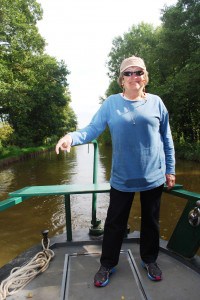 Along this part of the route, Linda took the opportunity to try her hand at driving the boat. Truth be told, it isn’t an easy boat to drive, as the rudder is bent, the tiller handle is also bent and doesn’t fit the shaft down to the rudder very well – with the result that the boat doesn’t track very well (this is a polite way to say, don’t look away for even a moment or the boat will be going in a direction you don’t want. After this experience, Linda wasn’t very excited about driving again.
Along this part of the route, Linda took the opportunity to try her hand at driving the boat. Truth be told, it isn’t an easy boat to drive, as the rudder is bent, the tiller handle is also bent and doesn’t fit the shaft down to the rudder very well – with the result that the boat doesn’t track very well (this is a polite way to say, don’t look away for even a moment or the boat will be going in a direction you don’t want. After this experience, Linda wasn’t very excited about driving again.
!
!
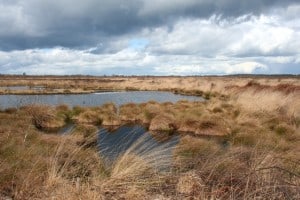 The terrain through this section, though, was interesting. It was very remote and most of the time the surrounding land was lower than the canal elevation. There were no signs of habitation whatsoever, although there were lots and lots of black and white cows scattered about – and you find yourself in the middle of “the Whixall Moss” … which in fact, is a peat bog that formerly provided commercial peat for gardens. But now it’s been turned into a nature preserve that’s popular with birders. I called the area the Grimpin Mire, as it looks exactly like the bog of that name in the Sherlock Holmes story, Hound of the Baskervilles (although that was set in Scotland – and it was full of quicksand and all sorts of unsavory characters that made it sinister).
The terrain through this section, though, was interesting. It was very remote and most of the time the surrounding land was lower than the canal elevation. There were no signs of habitation whatsoever, although there were lots and lots of black and white cows scattered about – and you find yourself in the middle of “the Whixall Moss” … which in fact, is a peat bog that formerly provided commercial peat for gardens. But now it’s been turned into a nature preserve that’s popular with birders. I called the area the Grimpin Mire, as it looks exactly like the bog of that name in the Sherlock Holmes story, Hound of the Baskervilles (although that was set in Scotland – and it was full of quicksand and all sorts of unsavory characters that made it sinister).
On our arrival in Ellesmere we found most of the moorage spots in the area already taken. This isn’t a good thing, as turnaround possibilities with a 66’ narrowboat are very limited – so it’s important that you take the first available place you come to. Recognizing this, we opted for the end of the moorage queue along the banks outside of town (photo below, with Tom and Kap discussing the day’s events on the stern deck, such as it is). We knew it would again be another long walk to dinner.
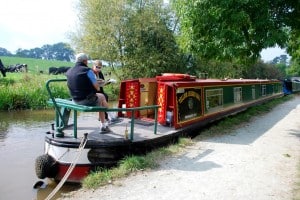 When it was time to walk into town we met an old gentlemen on the pathway with a cane, who we took to be a local out for a walk, and asked him for a pub/restaurant recommendation. He instantly came back with The Black Lion Hotel (are you seeing a pattern in pub names???), and then said he’d see us there shortly. If the place was good, we decided to “shout him a pint” (as the Brits, Kiwis, and Aussies say when you buy someone a round). It was good, but by now we could almost cite pub menus by heart.
When it was time to walk into town we met an old gentlemen on the pathway with a cane, who we took to be a local out for a walk, and asked him for a pub/restaurant recommendation. He instantly came back with The Black Lion Hotel (are you seeing a pattern in pub names???), and then said he’d see us there shortly. If the place was good, we decided to “shout him a pint” (as the Brits, Kiwis, and Aussies say when you buy someone a round). It was good, but by now we could almost cite pub menus by heart.
Tuesday, September 23, 2014, Ellesmere to Jack Mytton Inn. After a quick breakfast on the boat we headed for town to explore the large Tesco supermarket at the head of the canal stub (the stub was about 1,500’ long, and narrowboats were moored in every available spot). Tuesday is market day in Ellesmere, held in the large town hall in the center of town. It was part farmer’s market and part flea market – and we purchased two steak and ale and two pork and ale pies to take back to the boat (for the freezer, and a rainy day if we decided to stay on board for dinner). These are like a chicken pot pie, with a flaky crust encasing a meat and gravy center.
We then walked around the small town center, chancing upon a bakery that had several kinds of marinated olives (for all of us at Happy Hour except Kap). Although it was already mid-morning, we took the opportunity to indulge in an excellent latte at a sidewalk table and watched the world go by for a while. To our surprise, we learned the bakery opens at 7:30AM with the latte service, which we vowed to take advantage of on our return cruise, rather than the instant powder stuff we were drinking on the boat.
We didn’t strike out on the day’s cruise until after noon, deciding that it was to be a short day, and only 5½ miles distance. The task for the day was the Jack Mytton Inn, a highly popular pub in the extremely tiny village of Hindford (population maybe 10) that I’ll explain about in a bit.
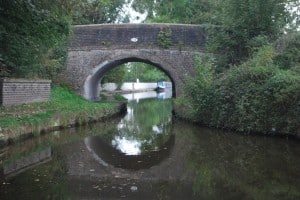 The scenery. So far, I think I’ve photographed almost every overhead bridge we’ve come to – as each seems more scenic than the last. The one in the photo at left is numbered 11W (on the oval plate above the center of the bridge arch, with the W meaning we’re in Wales), and with so many bridges to go through this gave us quick knowledge of exactly where we are at all times.
The scenery. So far, I think I’ve photographed almost every overhead bridge we’ve come to – as each seems more scenic than the last. The one in the photo at left is numbered 11W (on the oval plate above the center of the bridge arch, with the W meaning we’re in Wales), and with so many bridges to go through this gave us quick knowledge of exactly where we are at all times.
None of us had noticed it before, but Tom became curious why every bridge and lock has a large stone/brick box nearby – a box that was obviously built to last for a very long time (there’s one in the photo, at the extreme left, just before the bridge). After a close-up inspection we learned that each box has a half dozen very long 6×12 planks stacked in it, and we then noticed that the canal bank near it has a slot on each side of the bank to drop the boards into. Stacking the boards on edge, on top of each other, is an easy and effective way to dam up the canal, which makes lots of sense whenever there’s a breach in the canal wall. In three hundred years of operation, the canal engineers figured out how to handle all eventualities.
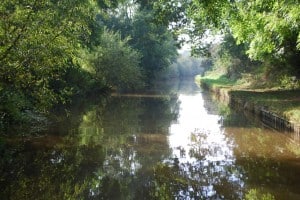 One of the best parts of canal scenery is the sun lighting through the trees, as well as reflections on the still water. It was at every turn, and made doubly nice on the frequent stretches where the canal traffic was so light that the water was like glass ahead of us. This is one of the benefits of cruising in this time of year, rather than July/August when the canals must be thick with boats churning up the water.
One of the best parts of canal scenery is the sun lighting through the trees, as well as reflections on the still water. It was at every turn, and made doubly nice on the frequent stretches where the canal traffic was so light that the water was like glass ahead of us. This is one of the benefits of cruising in this time of year, rather than July/August when the canals must be thick with boats churning up the water.
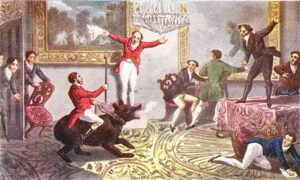 John “Mad Jack” Mytton. Lots of words can be used to describe this guy from 200 years ago (born 1796; died 1834): scurrilous, scandalous, outrageous, coarse, ribald, scabrous, eccentric, crazy, scalawag . . . you name it. Born into an illustrious (and very rich) family with a lineage over 500 years, and an annual income that would be worth $1M today, he broke almost every social rule in the books: riding a bear through the living room of his country estate (as the print above illustrates), setting his shirt afire to cure a bout of hiccups, taking 2,000 bottles of port to sustain him when he was sent to university at Cambridge (and continued to drink eight bottles of port a day in later life), paying voters £10 to vote for him when he stood for Parliament (and spending over $1M at today’s rate), attempting to jump a fence with a horse-drawn carriage (and failed), hunting naked even in snow storms, kept 2,000 dogs and 60 wildly decorated cats. He so loved his horse, Baronet, that he was allowed to roam the house and slept beside Jack in front of the drawing room fireplace. In the end, Mad Jack’s antics cost him his fortune, and he found himself locked up in debtor’s prison, where he died a broken man just 38 years old.
John “Mad Jack” Mytton. Lots of words can be used to describe this guy from 200 years ago (born 1796; died 1834): scurrilous, scandalous, outrageous, coarse, ribald, scabrous, eccentric, crazy, scalawag . . . you name it. Born into an illustrious (and very rich) family with a lineage over 500 years, and an annual income that would be worth $1M today, he broke almost every social rule in the books: riding a bear through the living room of his country estate (as the print above illustrates), setting his shirt afire to cure a bout of hiccups, taking 2,000 bottles of port to sustain him when he was sent to university at Cambridge (and continued to drink eight bottles of port a day in later life), paying voters £10 to vote for him when he stood for Parliament (and spending over $1M at today’s rate), attempting to jump a fence with a horse-drawn carriage (and failed), hunting naked even in snow storms, kept 2,000 dogs and 60 wildly decorated cats. He so loved his horse, Baronet, that he was allowed to roam the house and slept beside Jack in front of the drawing room fireplace. In the end, Mad Jack’s antics cost him his fortune, and he found himself locked up in debtor’s prison, where he died a broken man just 38 years old.
Why am I telling about this? Well, a local resident in Hindford runs a wonderful pub named the Jack Mytton Inn in honor of Hindford’s most famous former resident. The place had been highly recommended to us before we departed Wrenbury, so we decided this was our stop for the night. It was a Tuesday night, so we got by without a reservation, but on busy weekend nights this isn’t possible – the place is very popular with locals and narrowboat cruisers as well.
Nothing special about the menu – most of the typical pub favorites, but a couple of new ones that we decided to try. Linda had a lamb dish called “Local Welsh Lamb Henry”, slow cooked in a rich red wine and rosemary gravy, and served on mashed potatoes, with vegetables on the side. Tom and I both tried the rack of lamb, which was a bit more “pongy” than I like, but still good. Dessert was really … really! … good – a sticky toffee pudding. Almost every night after this, we tried each pub’s offering of this, to see which one might win the award for the best – but in the end, the Jack Mytton Inn version won.
Wednesday, September 24, 2014, Jack Mytton Inn to Chirk. Another day of only 5½ miles, but even though we slowly meandered along, it was a fairly short day with only one lock to pass through, one aqueduct of 710’ to cross, and the longest tunnel of the entire trip (the Chirk Tunnel, at 1,380’, or just over ¼ mile long). It was my day to drive almost all of it, including the tunnel at the very end of the day. We moored for the night just 100 yards from the west end of the tunnel mouth.
Most of the cruising day was the typical scenery – stuff that I’d already photographed several times before (and besides, I had my hands full with the tiller), so little to report . . . until we got to the Chirk Tunnel. I was finishing up a long day of driving, when suddenly there was the typical 90° bend in the canal, and shazam!, here was the mouth of a tunnel that seemed to stretch to infinity when I got lined up with the opening.
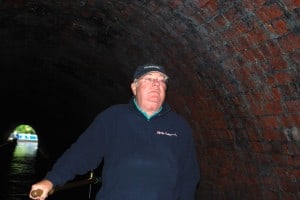 It was my first-ever tunnel, and for everyone else it was by far the longest (previously, the longest was maybe 50’). Once inside it, there was no light whatsoever around us, save for a little glow circle at the bow of the boat from the headlight. There was a very faint light ahead that was obviously the tunnel exit I was aiming for, and within a few yards into the tunnel, another faint semi-circle of light behind me. Other than that, I was steering blind.
It was my first-ever tunnel, and for everyone else it was by far the longest (previously, the longest was maybe 50’). Once inside it, there was no light whatsoever around us, save for a little glow circle at the bow of the boat from the headlight. There was a very faint light ahead that was obviously the tunnel exit I was aiming for, and within a few yards into the tunnel, another faint semi-circle of light behind me. Other than that, I was steering blind.
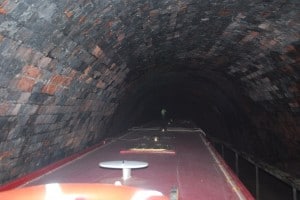 In the bottom photo, there’s light on the wall only because of my camera flash, which also seems to have snuffed out the “light at the end of the tunnel” and shows up here as a very faint dot just above the center bits on the boat roof.
In the bottom photo, there’s light on the wall only because of my camera flash, which also seems to have snuffed out the “light at the end of the tunnel” and shows up here as a very faint dot just above the center bits on the boat roof.
Now for the really scary part. Not long after entering the tunnel, our boat seemed to mysteriously slow down. I looked and looked at the barely visible pathway railing behind me, and sure enough it seemed like we were barely moving. I moved the throttle forward, then moved it again, and again, until I was running at top revs on the engine. It still seemed like we were barely moving, and worse, the other narrowboat that came in a couple hundred feet behind us seemed to be steadily gaining. What the hell was going on?
The boat also seemed unsteerable, and I could tell from the angle difference of the bow to the faint light ahead that we were indeed veering from side to side (and I was moving the tiller in wide sweeps, which was unusual). Could grinding the side of the boat against the tunnel rail at the water level be causing all this? I was totally mystified.
With the speed seriously reduced, it took us forever to reach the end of the tunnel, but finally we did. Once outside the tunnel I could readily see that our speed was badly diminished, but nothing made sense. Then we passed a privately-owned narrowboat waiting to enter after the tunnel was clear, and the wizened guy at the tiller hollered over to me, “Put it in reverse, then rev the engine up!” What he said didn’t make any sense, but I did what he told me. “You may have to do it multiple times,” he hollered again.
Finally, it made sense. At some point, our prop had built up a thick bunch of leaves from the fall leaves dropping in the water, and it had made our prop almost totally ineffective. Had I realized that while we were in the tunnel, we might have passed through in half the time. Live and learn.
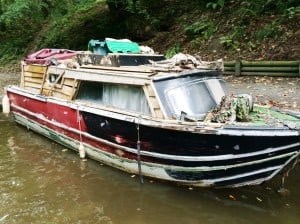 We planned to spend the night at Chirk, and the street leading to the town center was at a high bridge crossing just a couple hundred yards outside the tunnel that we just came through. With very little room to spare, I pulled to the side and Kap and Tom got us moored for the night. Directly ahead of us (by just a meter from our bow), though, was the skankiest boat we’d seen so far on the canal – obviously derelict, but who knows if there really was someone living on it. Kap didn’t want to be moored anywhere near it, but I felt it was just an abandoned boat. (That night, Linda wrote in her daily cruise e-mail to family and friends, “I was reading The Times and there was an article about a Latvian man who is wanted in the disappearance of a young girl from the towpath. I think that the scow is his hiding hole and he comes out to prey on the unsuspecting. I can’t be sure but maybe. There could be a novel in this.” While it was said jokingly, her comments definitely left an impact with us, and we didn’t look at the scow in the same way. (Near the end of our cruise, the young woman’s body was found, and a day later, the Latvian who is the prime suspect was also found dead. This tragic incident occurred in the River Brent, which is in northern London.)
We planned to spend the night at Chirk, and the street leading to the town center was at a high bridge crossing just a couple hundred yards outside the tunnel that we just came through. With very little room to spare, I pulled to the side and Kap and Tom got us moored for the night. Directly ahead of us (by just a meter from our bow), though, was the skankiest boat we’d seen so far on the canal – obviously derelict, but who knows if there really was someone living on it. Kap didn’t want to be moored anywhere near it, but I felt it was just an abandoned boat. (That night, Linda wrote in her daily cruise e-mail to family and friends, “I was reading The Times and there was an article about a Latvian man who is wanted in the disappearance of a young girl from the towpath. I think that the scow is his hiding hole and he comes out to prey on the unsuspecting. I can’t be sure but maybe. There could be a novel in this.” While it was said jokingly, her comments definitely left an impact with us, and we didn’t look at the scow in the same way. (Near the end of our cruise, the young woman’s body was found, and a day later, the Latvian who is the prime suspect was also found dead. This tragic incident occurred in the River Brent, which is in northern London.)
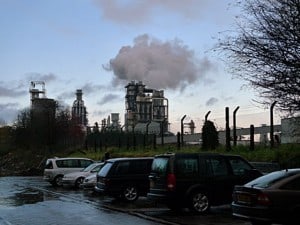 After tying up, we walked to Chirk. Less than a block from where we started, we all smelled the unmistakable aroma of cocoa – and a glance to the left brought out a large factory complex that is the Cadbury cocoa plant. It was really surprising that what we smelled was so like the finished product. (When we got to the factory’s entrance gates a block further, the corporate name of the factory was Mondelēz International, which none of us had ever heard of – in fact, we thought it was some European company. Turns out, Cadbury was bought in a hostile takeover in 2009 by Kraft Foods (which all of us somehow missed or forgot), and a later split of Kraft Foods into two parts created this company.) It’s sad when an almost 200 year old national icon is picked up by a corporate raider, but in reading about it, I learned that the shareholders made out very well.)
After tying up, we walked to Chirk. Less than a block from where we started, we all smelled the unmistakable aroma of cocoa – and a glance to the left brought out a large factory complex that is the Cadbury cocoa plant. It was really surprising that what we smelled was so like the finished product. (When we got to the factory’s entrance gates a block further, the corporate name of the factory was Mondelēz International, which none of us had ever heard of – in fact, we thought it was some European company. Turns out, Cadbury was bought in a hostile takeover in 2009 by Kraft Foods (which all of us somehow missed or forgot), and a later split of Kraft Foods into two parts created this company.) It’s sad when an almost 200 year old national icon is picked up by a corporate raider, but in reading about it, I learned that the shareholders made out very well.)
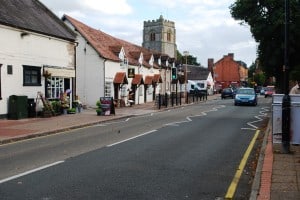 Once in town, we headed first to a chemist (pharmacy or drug store in our terms), as Kap had come down with a nasty cold and needed some meds to hopefully bring it under control. To find the chemist, we stopped in a small bakery to ask directions. Without thinking, I asked for directions to the “city center” . . . and the surprised young woman behind the counter stammered, “This is a very small village . . . this is the city center!” Oops – I pulled a gaff, by not having a clue about the size of Chirk before opening my mouth.
Once in town, we headed first to a chemist (pharmacy or drug store in our terms), as Kap had come down with a nasty cold and needed some meds to hopefully bring it under control. To find the chemist, we stopped in a small bakery to ask directions. Without thinking, I asked for directions to the “city center” . . . and the surprised young woman behind the counter stammered, “This is a very small village . . . this is the city center!” Oops – I pulled a gaff, by not having a clue about the size of Chirk before opening my mouth.
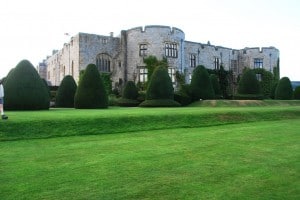 As the afternoon was getting on, we decided to get a look at the famous Chirk Castle, built in 1295 as part of the string of castles that defended the north of Wales. Our map indicated it’s on the outskirts of town and across the canal that we had just come from. We headed that direction, but it was soon obvious it was a 2-mile walk to the castle grounds, and then a 2-mile walk back. None of us were keen on that, so we called for a taxi to drive us there, wait for us at the castle door while we looked around, then bring us back to the city. It was a bit pricey, but certainly saved our legs.
As the afternoon was getting on, we decided to get a look at the famous Chirk Castle, built in 1295 as part of the string of castles that defended the north of Wales. Our map indicated it’s on the outskirts of town and across the canal that we had just come from. We headed that direction, but it was soon obvious it was a 2-mile walk to the castle grounds, and then a 2-mile walk back. None of us were keen on that, so we called for a taxi to drive us there, wait for us at the castle door while we looked around, then bring us back to the city. It was a bit pricey, but certainly saved our legs.
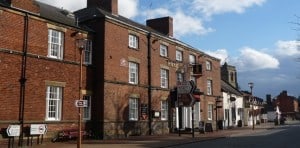 Like every night before, our only choice for dinner was the town’s pub, at The Hand Hotel. The menu was pretty much the same as all other pubs we’d eaten at in the recent past . . . with one exception – for a starter we each had a Welsh rarebit in honor of our first real meal in Wales (also spelled and pronounced as Welsh rabbit, which I originally thought contained rabbit meat). It’s traditionally a dish of doctored-up and melted cheddar cheese, poured over hunks of toasted bread. It was quite yummy.
Like every night before, our only choice for dinner was the town’s pub, at The Hand Hotel. The menu was pretty much the same as all other pubs we’d eaten at in the recent past . . . with one exception – for a starter we each had a Welsh rarebit in honor of our first real meal in Wales (also spelled and pronounced as Welsh rabbit, which I originally thought contained rabbit meat). It’s traditionally a dish of doctored-up and melted cheddar cheese, poured over hunks of toasted bread. It was quite yummy.
Interestingly, I’ve eaten Welsh rarebit a number of times and even have a recipe for it in my recipe files. I first learned of it on one of my teaching visits to Springfield, IL – where I often taught classes back in the 1980s for IT professionals working at the State of Illinois computer center. A Springfield restaurant had a specialty of rarebit, but their twist on it was to serve it over French fries, and it too was quite good, even though it wasn’t the real thing.
Thursday, September 25, 2014, Chirk to Llangollen. Today’s cruise is 8 miles, but they will undoubtedly be the most interesting 8 miles of the entire trip. It’s Tom’s day to drive (although we had dispensed with the idea of one person driving the entire day, as it proved too tiring). Kap and I would be in the bow “spotting” for Tom, and Linda would be at the stern to help keep track of exactly where we were and what was coming up next.
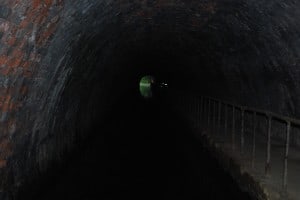 Our first major event of the day was the Whitehouse Tunnel, the shorter cousin to the Chirk Tunnel we passed through yesterday afternoon – at only 565’, or less than half the length. The photo at left isn’t a black-as-night blank photo, but rather, a photo taken from the bow of our narrowboat as we entered the Whitehouse Tunnel (and you’ll almost certainly have to click on the photo to enlarge it to see the “light at the end of the tunnel”. As usual, there’s a sharp turn at the end, and that’s another narrowboat making the turn that you can barely see in the murky dark ahead. As Linda put it in her e-mail home, “Entering a tunnel or bridge is like threading a needle 60’ ahead of you. You are moving the 6½’ bow into an 8′ opening and it seems that the approach is almost always angled. We are going up stream and the current can move your bow as it comes through the narrow opening.” All definitely true.
Our first major event of the day was the Whitehouse Tunnel, the shorter cousin to the Chirk Tunnel we passed through yesterday afternoon – at only 565’, or less than half the length. The photo at left isn’t a black-as-night blank photo, but rather, a photo taken from the bow of our narrowboat as we entered the Whitehouse Tunnel (and you’ll almost certainly have to click on the photo to enlarge it to see the “light at the end of the tunnel”. As usual, there’s a sharp turn at the end, and that’s another narrowboat making the turn that you can barely see in the murky dark ahead. As Linda put it in her e-mail home, “Entering a tunnel or bridge is like threading a needle 60’ ahead of you. You are moving the 6½’ bow into an 8′ opening and it seems that the approach is almost always angled. We are going up stream and the current can move your bow as it comes through the narrow opening.” All definitely true.
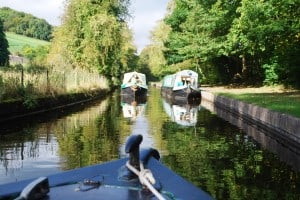 What does a “sticky wicket” look like? Everyone knows the term, but how many know what it actually means. Well, it’s “a difficult circumstance” – and originates from the game of cricket, caused by the difficulty in batting caused by a pitch on damp and soft ground. You could also say that the predicament Tom found himself in the photo at left is a very sticky wicket. We’re cruising right down the middle of the canal, at a point where it’s wide enough for little more than two boats. There’s a boat moored on the right, and just at the point of our meeting is another boat coming right down the middle of what’s left. The solution is to pull back the throttle, cruise to dead slow to wait until the oncoming boat passes, steer a bit to the right, then swing in just after the oncoming boat clears the moored boat. Oddly, after going for miles without meeting or seeing another boat, we’d often find ourselves in this type of sticky wicket.
What does a “sticky wicket” look like? Everyone knows the term, but how many know what it actually means. Well, it’s “a difficult circumstance” – and originates from the game of cricket, caused by the difficulty in batting caused by a pitch on damp and soft ground. You could also say that the predicament Tom found himself in the photo at left is a very sticky wicket. We’re cruising right down the middle of the canal, at a point where it’s wide enough for little more than two boats. There’s a boat moored on the right, and just at the point of our meeting is another boat coming right down the middle of what’s left. The solution is to pull back the throttle, cruise to dead slow to wait until the oncoming boat passes, steer a bit to the right, then swing in just after the oncoming boat clears the moored boat. Oddly, after going for miles without meeting or seeing another boat, we’d often find ourselves in this type of sticky wicket.
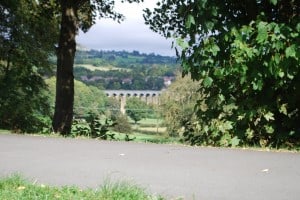 As we cruised through an area that was more heavily populated than anything we’d seen so far, I spotted something interesting through the trees to my right – an impressive aqueduct that looked a lot like the Pontcysyllte Aqueduct I’d seen so many photos of. I thought we were still quite a ways from the aqueduct, so even though I snapped this photo, I just thought it was an interesting scene. As we rounded a sharp 90° bend to the right in a few minutes, Kap and I were both startled to see the famous aqueduct straight ahead of us. At first it seemed quite innocuous, and hardly as impressive as the photos I’ve seen. It certainly didn’t look like it was almost a quarter of a mile long, and it didn’t give the impression of sitting out there in thin air!
As we cruised through an area that was more heavily populated than anything we’d seen so far, I spotted something interesting through the trees to my right – an impressive aqueduct that looked a lot like the Pontcysyllte Aqueduct I’d seen so many photos of. I thought we were still quite a ways from the aqueduct, so even though I snapped this photo, I just thought it was an interesting scene. As we rounded a sharp 90° bend to the right in a few minutes, Kap and I were both startled to see the famous aqueduct straight ahead of us. At first it seemed quite innocuous, and hardly as impressive as the photos I’ve seen. It certainly didn’t look like it was almost a quarter of a mile long, and it didn’t give the impression of sitting out there in thin air!
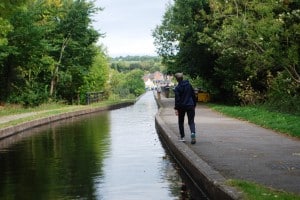 Kap immediately jumped from the boat to the towpath, instantly realizing that our sequence to enter the one-boat-at-a-time aqueduct would depend on how sharp we were at “reading” what was going on at the other end. At first, it appeared that another narrowboat had just entered the aqueduct – which could easily mean that others would follow, possibly delaying us interminably for our start across – but Kap’s keen eyes figured out that the boat was in a basin on the other side, and the aqueduct was clear for us. She quickly motioned for Tom to move into the aqueduct as soon as he could get there . . . and before we knew it, we were heading across the aqueduct!
Kap immediately jumped from the boat to the towpath, instantly realizing that our sequence to enter the one-boat-at-a-time aqueduct would depend on how sharp we were at “reading” what was going on at the other end. At first, it appeared that another narrowboat had just entered the aqueduct – which could easily mean that others would follow, possibly delaying us interminably for our start across – but Kap’s keen eyes figured out that the boat was in a basin on the other side, and the aqueduct was clear for us. She quickly motioned for Tom to move into the aqueduct as soon as he could get there . . . and before we knew it, we were heading across the aqueduct!
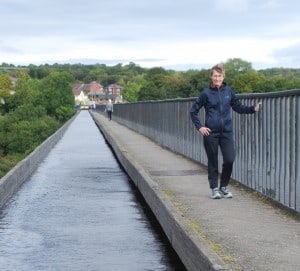 And here we are – crossing the Pontcysyllte Aqueduct! I’m in the bow of the boat, Kap has been walking alongside on the pathway on the right side (but after posing for this photo jumps back into the boat). We’re 126’ above the River Dee in valley below, and this little trickle of water is just barely the width of our boat. More shocking is that the side wall on the left is less than 12” above the water line, and it’s all that’s holding us from going off the side. What a rush!
And here we are – crossing the Pontcysyllte Aqueduct! I’m in the bow of the boat, Kap has been walking alongside on the pathway on the right side (but after posing for this photo jumps back into the boat). We’re 126’ above the River Dee in valley below, and this little trickle of water is just barely the width of our boat. More shocking is that the side wall on the left is less than 12” above the water line, and it’s all that’s holding us from going off the side. What a rush!
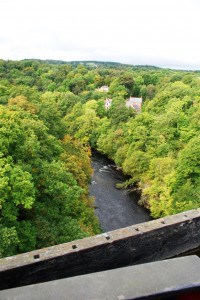 Adding to the rush is a very strong wind – that’s thankfully blowing from the left, pushing us towards the more secure pathway on our right.
Adding to the rush is a very strong wind – that’s thankfully blowing from the left, pushing us towards the more secure pathway on our right.
I hated to think about even doing it, but I screwed up my courage, leaned across Kap on my left, and looking straight at the piddly steel lip holding us in this trough, I snapped a photo of the River Dee far below (the trough lip is the small metal piece with the closely-spaced bolt heads showing).
!
!
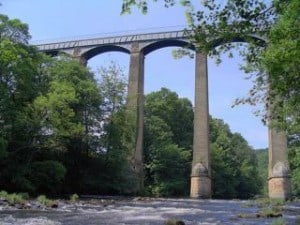 Soon we were across and the terror was over (and the photo at left that I cadged from the Canal Guide should help explain my terror). In the cold light of day afterwards, I could understand that thousands and thousands of people have crossed this aqueduct in a narrowboat, plus even more tourist and local people walking across on the towpath – but that didn’t make me feel any less nervous about how precarious it all seemed as we were on it. This aqueduct has been standing since 1805, and before it became a major tourist attraction it was a working structure that hauled freight barges across it for 1½ centuries, so it has really stood the test of time.
Soon we were across and the terror was over (and the photo at left that I cadged from the Canal Guide should help explain my terror). In the cold light of day afterwards, I could understand that thousands and thousands of people have crossed this aqueduct in a narrowboat, plus even more tourist and local people walking across on the towpath – but that didn’t make me feel any less nervous about how precarious it all seemed as we were on it. This aqueduct has been standing since 1805, and before it became a major tourist attraction it was a working structure that hauled freight barges across it for 1½ centuries, so it has really stood the test of time.
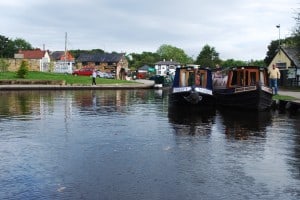 The last leg. The western end of the aqueduct immediately dumped us into a round basin that was maybe 80’ in diameter (shown directly ahead in the photo at left). From the front of our boat, I could see there were two exits from the basin, one directly to the north in our current path and one to the west, a sharp 90° turn to our left. A continuous line of other narrowboats lined the basin on our right, and it appeared they were waiting to enter the aqueduct (which made me wonder why they didn’t do so before we got a chance to). At the back, Tom yelled to Kap, “Which way do I go?”. To me, it looked obvious that we should continue straight, but Kap yelled back, “To the left!” I thought she was crazy, as it was by far the narrowest canal, with an unfinished retaining wall on both sides. She had a map in her hand, though, so I took her at her word.
The last leg. The western end of the aqueduct immediately dumped us into a round basin that was maybe 80’ in diameter (shown directly ahead in the photo at left). From the front of our boat, I could see there were two exits from the basin, one directly to the north in our current path and one to the west, a sharp 90° turn to our left. A continuous line of other narrowboats lined the basin on our right, and it appeared they were waiting to enter the aqueduct (which made me wonder why they didn’t do so before we got a chance to). At the back, Tom yelled to Kap, “Which way do I go?”. To me, it looked obvious that we should continue straight, but Kap yelled back, “To the left!” I thought she was crazy, as it was by far the narrowest canal, with an unfinished retaining wall on both sides. She had a map in her hand, though, so I took her at her word.
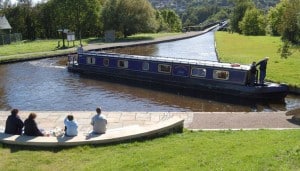 Tom had barely begun his turn to the left when the steel bow of our boat crashed hard (and loudly) into the concrete edge of the basin (at the far left of the photo above). Before I could do anything, two guys standing on the sidewalk directly in front of us came forward to help push our bow to the left. I looked back at Tom, thinking rather unflattering thoughts, when I realized the stern was almost jammed into the boats behind and Tom was doing his best to get us turned, with only inches to spare on both bow and stern. With lots of effort from the two guys on the sidewalk, the bow swung around the necessary 90° and we entered the canal. (The photo below mine was taken from the Canal & River Trust site, and shows the basin, and a narrowboat making the 90° bend just as we had . . . but with one big difference – there are no other boats lining the bank where the boat’s stern is, which allows a lot more room for this boat to safely make the turn. For us, the bow hit the sidewalk area just in front of where the people are sitting, and that’s where the two guys helped us make the turn. Can you imagine turning a 66’ boat to the left with other boats in this basin?)
Tom had barely begun his turn to the left when the steel bow of our boat crashed hard (and loudly) into the concrete edge of the basin (at the far left of the photo above). Before I could do anything, two guys standing on the sidewalk directly in front of us came forward to help push our bow to the left. I looked back at Tom, thinking rather unflattering thoughts, when I realized the stern was almost jammed into the boats behind and Tom was doing his best to get us turned, with only inches to spare on both bow and stern. With lots of effort from the two guys on the sidewalk, the bow swung around the necessary 90° and we entered the canal. (The photo below mine was taken from the Canal & River Trust site, and shows the basin, and a narrowboat making the 90° bend just as we had . . . but with one big difference – there are no other boats lining the bank where the boat’s stern is, which allows a lot more room for this boat to safely make the turn. For us, the bow hit the sidewalk area just in front of where the people are sitting, and that’s where the two guys helped us make the turn. Can you imagine turning a 66’ boat to the left with other boats in this basin?)
No sooner had we turned into the final canal to Llangollen than we saw a wide beam (maybe 10’ wide) cruise boat ahead and approaching us (it was still a narrowboat, at least as long as us, but a few feet wider, with all glass walls and roof, carrying about 50 tourists), and it was taking its proverbial half out of the center of the canal. I’m sure Tom’s sphincter muscle tightened (pardon me for saying so, Tom), but he managed to get by without any problem.
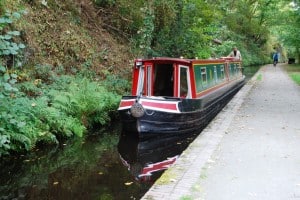 We were now on the final canal run into Llangollen. Ahead was our last five miles, and since it was built mostly to provide the water for the canal below, it was more rugged and often wide enough for only one boat. Turnouts were few and far between, so Kap walked ahead on the pathway to check for any boats coming toward us.
We were now on the final canal run into Llangollen. Ahead was our last five miles, and since it was built mostly to provide the water for the canal below, it was more rugged and often wide enough for only one boat. Turnouts were few and far between, so Kap walked ahead on the pathway to check for any boats coming toward us.
The terrain had turned rugged and mountainous. To our left we could see down to the Vale of Llangollen a few hundred feet below, and to our right was steep bank. From the looks of the terrain and the houses perched on the hillside across the Vale, I would have guessed we were in Switzerland. What a difference from the mostly flat and gently rolling terrain we had just spent four days passing through.
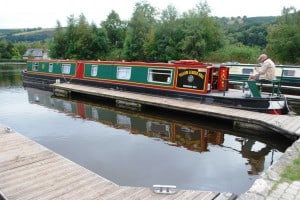 Finally, the village of Llangollen announced itself. As Linda wrote in her e-mail diary, “We arrived at Llangollen, which is the turnaround point for this canal. It is a lovely town nestled against the hillside with the River Dee winding through it. Much larger than any of the other villages we have visited. We walked around and found the laundromat, we will go in tomorrow morning to do some laundry. We had dinner in a lovely restaurant, The Gallery. We tested another Sticky Toffee Pudding and I felt that Mad Jack Mytton had the better rendition. We are moored in a basin, sort of like a mobile home park for boats. This is our first paid dockage, £6/night.”
Finally, the village of Llangollen announced itself. As Linda wrote in her e-mail diary, “We arrived at Llangollen, which is the turnaround point for this canal. It is a lovely town nestled against the hillside with the River Dee winding through it. Much larger than any of the other villages we have visited. We walked around and found the laundromat, we will go in tomorrow morning to do some laundry. We had dinner in a lovely restaurant, The Gallery. We tested another Sticky Toffee Pudding and I felt that Mad Jack Mytton had the better rendition. We are moored in a basin, sort of like a mobile home park for boats. This is our first paid dockage, £6/night.”
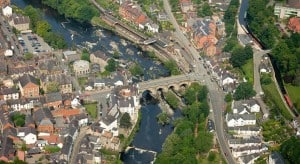 I wasn’t able to get a good vantage point for a photo of Llangollen, so I grabbed the aerial photo at left from the village’s website. It shows the River Dee flowing through town, with the city center on the left, the railway station just above the river bridge, and the canal snaking up the right side of the photo. The basin we moored in is just outside the top of the photo.
I wasn’t able to get a good vantage point for a photo of Llangollen, so I grabbed the aerial photo at left from the village’s website. It shows the River Dee flowing through town, with the city center on the left, the railway station just above the river bridge, and the canal snaking up the right side of the photo. The basin we moored in is just outside the top of the photo.
We spent two leisure days in Llangollen, getting some laundry done, strolling through shops, buying provisions, and having lunches and dinners. By now we were getting thoroughly tired of pub food, and The Gallery that Linda mentioned was a very welcome change – a very small, but proper restaurant in the center of the village. We were also very tired physically, partly from several days of not-so-good sleep in the beds on board the Yellow Legged Gull, but also from the long days on the water – mind you, it wasn’t hard work, but there were constantly new things to see, so we were always on the bow or stern of the boat taking in the world as it passed by.
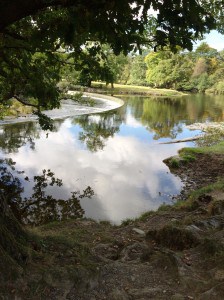 The best part (at least for me) of our Llangollen stay was an afternoon-long, 4-mile round trip walk to the Horseshoe Falls, further up the River Dee from town, where as much as 12,000,000 gallons/day of river water are diverted into the canal to flush water into it. We walked the towpath alongside the canal, but it was just a narrow, shallow service canal, and boats over 10’ in length are not allowed.
The best part (at least for me) of our Llangollen stay was an afternoon-long, 4-mile round trip walk to the Horseshoe Falls, further up the River Dee from town, where as much as 12,000,000 gallons/day of river water are diverted into the canal to flush water into it. We walked the towpath alongside the canal, but it was just a narrow, shallow service canal, and boats over 10’ in length are not allowed.
None of us had any idea what to expect of Horseshoe Falls, except that we figured it would be a spectacular cascading waterfalls from some high bluff. Instead, it was an idyllic setting where the River Dee widened, then splashed over a gentle 3’ tall, perfectly round half, crescent ledge. Fifty yards below that, the canal builders created a diversion where a small part of the river flowed into a man-made stream that soon became the Llangollen Canal.
Pronunciations in Welsh. By now, you’ve read the word Llangollen in your mind a hundred times, and almost certainly have formed your own idea of how it’s pronounced. Well, chances are you don’t have a background in Welsh language rules, and the real pronunciation almost certainly won’t be what you guessed. First, you have to stick the back of your tongue against the roof of your mouth to make a “kkkhhsch” type of sound. Then pronounce the first double ll’s as a “kl” sound, and the second double ll’s as an “fl” sound, and there you have it . . . “klang-golf’-len”.
Another place name that you’ve probably struggled with in this post is Pontcysyllte – and you’ve probably concluded that it’s “pont-si-silt”. Wrong again. It’s “pont-ker-sulth-tee”. Go figure.
Only 3% of Welsh people speak the language today, which is based on old Celtic, but all signs in the country are in both English and Welsh. All I can say about it is, to American ears it’s weird. The written language has amazing strings of unpronounceable consonants, then a lonely vowel, then more consonants.
Saturday, September 27, 2014, Llangollen to Jack Mytton Inn . . . and Homeward Bound. Today marks the turnaround point of our out-and-return journey on the Llangollen Canal. Since we’ve already covered this ground (or water), I wondered if it would just be long and boring, but it definitely wasn’t. The scenery in the opposite direction was surprisingly different, and the peace and quiet of canal cruising made for really enjoyable days. It was only at the very end that we developed a touch of get-home-itis, truncating our two weeks by two days (and then only because we were back at Wrenbury with nowhere else to go).
This morning was the first that Tom and Linda learned of Kap’s determination when she decides it’s time to leave a place (I learned it long ago on Flying Colours, so I was prepared for it). Until now, our mornings had mostly been leisurely – with brisk mornings the boat was very cold when we first awoke, so Kap would be up by 7AM to start the diesel heater to take the chill off the boat – and to get the water heated for Tom’s shower. She also ran the main engine for a while, as the house battery bank was usually low enough in the morning to need some charge. I was always the first at the breakfast table with some toast and marmalade and an instant latte. By 8AM Tom and Linda would show up for their breakfast. With no fixed schedule, we often didn’t start our day’s cruise until 10 or 11AM. The thought was, we had plenty of time for this out-and-return cruise, so why rush?
For some reason, Kap had it in her mind that we’d leave early today – mostly because she was concerned that other narrowboat traffic (coming towards us between the Pontcysyllte Aqueduct and Llangollen, where a good portion is just a single lane wide) would be heavy and we could be forced to wait for long periods. Thinking this all through, Kap was determined to leave the moorage basin at Llangollen at 8:30AM. Poor Tom and Linda, who didn’t know of Kap’s plan and had barely sat down at the dinette for breakfast when Kap fired up the main engine. The two of us slipped our lines, and we headed out to the canal almost before they knew what was going on. I was at the tiller and Kap walked ahead on the towpath to scout out any oncoming boats. There weren’t any, and we didn’t see a single boat until we reached Pontcysyltte, so her plan must have been good.
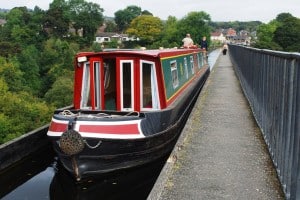 This time as we crossed the Pontcysyllte Aqueduct, I arranged for Kap to be at the tiller and I hopped off to the sidewalk/towpath alongside to get some photos of our crossing. The terror of crossing had subsided – but just a bit. It didn’t help that thousands of first-time tourists in narrowboats have safely crossed this aqueduct, not to mention at least 150 years of working canal boats that have crossed for real work purposes – presumably all safe. Being 126’ above the River Dee, in a trough of water with almost no structure to it on one side, just can’t help to create an honest fear in anyone. Nevertheless, it was a tremendous amount of fun, and I wouldn’t trade it for anything!
This time as we crossed the Pontcysyllte Aqueduct, I arranged for Kap to be at the tiller and I hopped off to the sidewalk/towpath alongside to get some photos of our crossing. The terror of crossing had subsided – but just a bit. It didn’t help that thousands of first-time tourists in narrowboats have safely crossed this aqueduct, not to mention at least 150 years of working canal boats that have crossed for real work purposes – presumably all safe. Being 126’ above the River Dee, in a trough of water with almost no structure to it on one side, just can’t help to create an honest fear in anyone. Nevertheless, it was a tremendous amount of fun, and I wouldn’t trade it for anything!
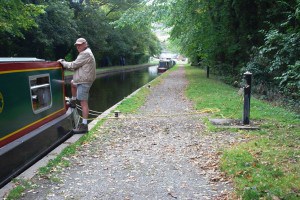 Once across the aqueduct, Kap wanted to stop for a fresh water tank refill at a spot where there were three potable water stations, each about 70’ apart.
Once across the aqueduct, Kap wanted to stop for a fresh water tank refill at a spot where there were three potable water stations, each about 70’ apart.
!
!
!
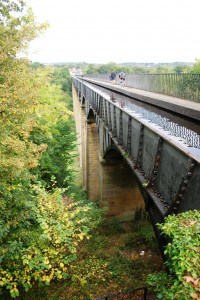 As Tom and Kap managed the water fill, Linda and I walked back to the aqueduct’s edge to take more photos. There, we discovered a walkway under the canal that gave us a really good vantage point to see the structure that brought us across.
As Tom and Kap managed the water fill, Linda and I walked back to the aqueduct’s edge to take more photos. There, we discovered a walkway under the canal that gave us a really good vantage point to see the structure that brought us across.
After crossing this aqueduct twice, all I can say is that it is magnificent – and amazingly, that totally novice canal boat drivers would be allowed to drive across this. (If nothing else, this says a lot about the difference in personal liability laws between the U.K. and the U.S. Frankly, I can’t imagine anything like this being allowed in the U.S., mostly because of our legal system that has made a mockery of each individual taking responsibility for his/her own actions, suing the hell out of everyone in sight if the slightest thing goes wrong. But, enough on my soapbox.)
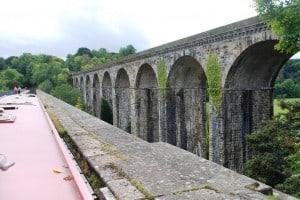 Continuing our journey east, we were soon at the 70’ high Chirk Aqueduct, much shorter than the Pontcysyllte Aqueduct that we’d just crossed a few minutes earlier (at 660’ long) – and sort of overshadowed by it . . . until that is, you add in the very impressive railway aqueduct running right alongside it. For whatever reason (logistics, cost, time constraints), when we built a railway bridge in America in the early days of the Industrial Revolution, they were usually wooden trestles – and by now have deteriorated to the point of being unusable. By comparison, in the U.K. they built them as the Romans built their water aqueducts – of stone and brick, and to last not just for a hundred years, but for a millennium.
Continuing our journey east, we were soon at the 70’ high Chirk Aqueduct, much shorter than the Pontcysyllte Aqueduct that we’d just crossed a few minutes earlier (at 660’ long) – and sort of overshadowed by it . . . until that is, you add in the very impressive railway aqueduct running right alongside it. For whatever reason (logistics, cost, time constraints), when we built a railway bridge in America in the early days of the Industrial Revolution, they were usually wooden trestles – and by now have deteriorated to the point of being unusable. By comparison, in the U.K. they built them as the Romans built their water aqueducts – of stone and brick, and to last not just for a hundred years, but for a millennium.
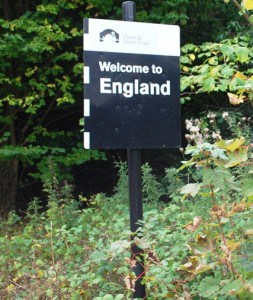 Immediately after we exited the east end of the Chirk Aqueduct, a simple sign reading “Welcome to England” announced that we’d once again crossed back into England (but it wouldn’t be the last time on this cruise). Such simplicity may have been intentional, as the nationalistic issue with Scotland, Wales, and Northern Ireland breaking away from the U.K. is a very real issue right now. (The day following our arrival – September 18th – Scotland voted on whether to secede, and right up to election day it was a toss-up over which way it would go. In the end, the vote was to stay in the U.K., but it wasn’t a foregone conclusion. The feeling is that Wales may be the next to vote.)
Immediately after we exited the east end of the Chirk Aqueduct, a simple sign reading “Welcome to England” announced that we’d once again crossed back into England (but it wouldn’t be the last time on this cruise). Such simplicity may have been intentional, as the nationalistic issue with Scotland, Wales, and Northern Ireland breaking away from the U.K. is a very real issue right now. (The day following our arrival – September 18th – Scotland voted on whether to secede, and right up to election day it was a toss-up over which way it would go. In the end, the vote was to stay in the U.K., but it wasn’t a foregone conclusion. The feeling is that Wales may be the next to vote.)
We weren’t really sure if we could put on enough miles in a day to make it all the way back to Mad Jack Mytton’s Inn. It had taken us two cruising days on the outbound journey to go this distance, but they were short days due to some serious sightseeing. Our speed this time was also helped by a 2 knot current of the canal running in our favor. As a result, we pulled into the moorage slots outside the Inn in mid-afternoon – just in time for an early Happy Hour.
The main topic of conversation over Happy Hour was what to do with our last week on the narrowboat. It would still take us a minimum of 2+ days to return to Wrenbury Mill, but we had six full days to do it in and we all agreed there weren’t additional things to see on our route home to do it that slowly. The options were: (1) take a detour tomorrow on the Montgomery Canal, currently a short stub leading south from the Llangollen Canal; (2) head for Wrenbury Mill, continue past it and head north on the section of the Shropshire Union Canal that leads to Chester (where Kap and I stayed on our arrival); (3) continue past Wrenbury Mill and go to Nantwich on the section of the Shropshire Union Canal that leads south. They all sounded attractive, but option 2 really needed a bit more time than we had if we wanted to actually spend some time in Chester. Option 3 was also a bit too long, and we had a feeling it would only be more of what we’re already seeing, and staying on the boat for two extra days just for the sake of staying on it didn’t make sense. In the end, our choice was option 1.
Once again we had a good pub dinner at Mad Jack’s, and the Sticky Toffee Pudding for dessert confirmed our vote for the best rendition along the canal.
After dinner we read up on all the info we had in our guide books about the Montgomery Canal and talked everything over at length. It’s a canal section that’s only open for about 8 miles, ending at the tiny, tiny village of Maesbury Marsh (the original canal continues further south, but it hasn’t been restored to use yet, so the navigable portion ends at the village). Whether restoration will ever be completed is up for grabs, as in recent years there have been environmental concerns raised over the possible destruction of bird and animal habitats that have grown up in the area since the canal routes were abandoned (due to the canal water, both sides of the canals are lush with vegetation, even though the abandoned canals weren’t carrying water). Apparently the birding folks have successfully argued that significant avian species will be damaged if further restoration work is done, and at this point there’s an impasse. As a result, the banks even along the navigable sections of the Montgomery Canal have been left in a primitive state, and due to limited places for narrowboats to moor or tie up, only twelve boats are allowed on the canal at any time.
There is a series of five locks just as you head into the Montgomery Canal, three of them stair step locks that are manned by a lockkeeper, and that’s how they enforce the boat limit. The lockkeeper is only on duty from 12 noon to 2PM, so you have to be in this narrow time window if you wish to enter or exit the canal. A phone-ahead system is in place to make a reservation to be one of the twelve boats, and if you wish to travel on the canal you must call the Canal & River Trust by 10AM to see if you can get in the queue. Unfortunately, at the Jack Mytton Inn area we had very poor cell phone reception, and we could not reach them. We decided to charge on, and given that we were now almost in October (i.e., the slow season), maybe we could jump in line without the advance reservation. It was worth a try.
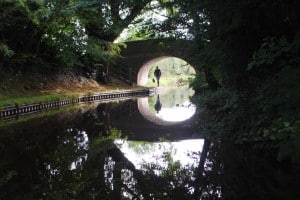 Sunday, September 28, 2014, Jack Mytton Inn (Hinford) to Maesbury Marsh. As we began our morning cruise, the scenery from the early morning’s light continued to awe us. The photo at left was snapped at a bridge approach that would otherwise just be another of the beautiful bridges along the way. What made it special, though, was the filtered light through the trees, the still water reflections, and the backlit man walking his dog.
Sunday, September 28, 2014, Jack Mytton Inn (Hinford) to Maesbury Marsh. As we began our morning cruise, the scenery from the early morning’s light continued to awe us. The photo at left was snapped at a bridge approach that would otherwise just be another of the beautiful bridges along the way. What made it special, though, was the filtered light through the trees, the still water reflections, and the backlit man walking his dog.
By 10:30AM we arrived at the Montgomery Canal junction. Displaying our vast (or maybe “half-vast”) knowledge of how cumbersome it is to maneuver a narrowboat in tight circumstances, we moored before a bridge near the junction (otherwise there would have been no place to turn around, or possibly even wait until noon). Kap and I walked ahead to scout out the situation. The lockkeeper had not yet arrived for his/her shift, but there were already two narrowboats tied up in the locks waiting area and the occupants were sitting around having a cup of coffee. Perfect! We’ll chat them up. Both were privately-owned narrowboats, and both have been down the Montgomery Canal multiple times (this is the fifth time for one of them, and they spend a week on this 8 mile stretch, so they must really like it).
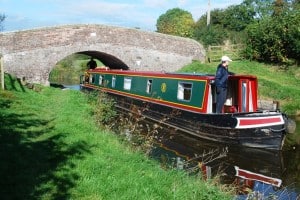 At noon the lockkeeper arrived – a young woman who we took to be a volunteer for the River & Canal Trust, but in fact she’s a paid employee (she commented, “and I get paid for having this fun”). We explained our situation, that we’d tried to telephone for a reservation but couldn’t reach anyone, so she whipped out her cell phone and called in for us. No problem, we got our reservation clearance, and we signaled for Tom and Linda to bring the Yellow Legged Gull forward.
At noon the lockkeeper arrived – a young woman who we took to be a volunteer for the River & Canal Trust, but in fact she’s a paid employee (she commented, “and I get paid for having this fun”). We explained our situation, that we’d tried to telephone for a reservation but couldn’t reach anyone, so she whipped out her cell phone and called in for us. No problem, we got our reservation clearance, and we signaled for Tom and Linda to bring the Yellow Legged Gull forward.
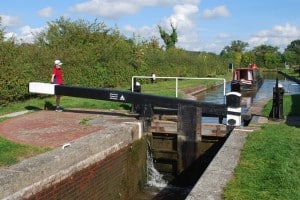 I have a complete set of photographs of the lock operation, so it might be interesting to show exactly how the locks operate. In this situation, we’re going “down” the canal, meaning that at our approach to the lock we’re at a higher elevation than we’ll be when we exit the lock. In the first photo, as the Yellow Legged Gull approaches, another boat ahead of us has just been let down, so the water level in the lock is at the bottom. Kap and the lockkeeper have just opened the upper fill gates at the big single lock door, and water will rush in to fill the lock.
I have a complete set of photographs of the lock operation, so it might be interesting to show exactly how the locks operate. In this situation, we’re going “down” the canal, meaning that at our approach to the lock we’re at a higher elevation than we’ll be when we exit the lock. In the first photo, as the Yellow Legged Gull approaches, another boat ahead of us has just been let down, so the water level in the lock is at the bottom. Kap and the lockkeeper have just opened the upper fill gates at the big single lock door, and water will rush in to fill the lock.
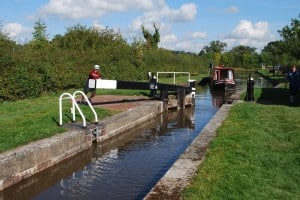 In the second photo, the lock is now filled and Kap is using the massive wooden arm (10’ long, 12”x12” square) to open the lock gate. Tom can now begin to maneuver the Yellow Legged Gull into the lock.
In the second photo, the lock is now filled and Kap is using the massive wooden arm (10’ long, 12”x12” square) to open the lock gate. Tom can now begin to maneuver the Yellow Legged Gull into the lock.
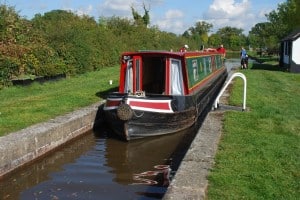 In the third photo, once the Yellow Legged Gull is completely inside the lock, Kap will then close the gate and crank down the water flood gate (and the lockkeeper will do the same on the other side – that’s the lockkeeper in the blue shirt). At the time I snapped this photo the boat wasn’t fully in the lock – that’s obvious because the lock is only 70’ long (or so), and there’s still plenty of room in front of the boat.
In the third photo, once the Yellow Legged Gull is completely inside the lock, Kap will then close the gate and crank down the water flood gate (and the lockkeeper will do the same on the other side – that’s the lockkeeper in the blue shirt). At the time I snapped this photo the boat wasn’t fully in the lock – that’s obvious because the lock is only 70’ long (or so), and there’s still plenty of room in front of the boat.
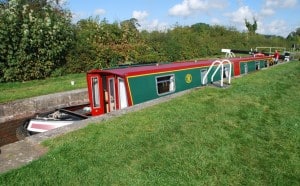 In the fourth photo, Kap and the lockkeeper (both out of sight behind me) have opened the water gates at the lock gate near the bow of the Yellow Legged Gull, and she’s beginning to lower in the lock. The tricky part of this is for the boat driver, as the water rushing out (if you’re going “down lock” or rushing in if you’re going “up lock”) is creating an artificial current inside the lock, jostling the boat back and forth, forward and back, and you have to constantly use the throttle and prop to keep the boat positioned where it should be inside the lock (more about this later).
In the fourth photo, Kap and the lockkeeper (both out of sight behind me) have opened the water gates at the lock gate near the bow of the Yellow Legged Gull, and she’s beginning to lower in the lock. The tricky part of this is for the boat driver, as the water rushing out (if you’re going “down lock” or rushing in if you’re going “up lock”) is creating an artificial current inside the lock, jostling the boat back and forth, forward and back, and you have to constantly use the throttle and prop to keep the boat positioned where it should be inside the lock (more about this later).
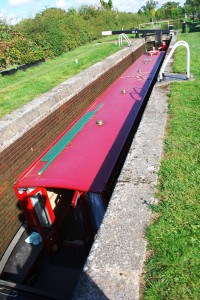 In the fifth photo, the lock has now been drained to the water level ahead, the boat is sitting almost out of sight inside the lock, and it’s time to exit the lock. This might seem like a scary part of the lock transit, but in fact, it isn’t much at all. As the driver, you’re pretty well hemmed in by the lock walls, and except for the slime and seaweed that you try to ignore growing on the brick walls of the lock, you’re just sitting there ready to go. When you start to move out, you give it a tiny bit of power and just drive out. (I might point out that Kap and I have quite a bit of experience with locks, transiting the Hiram Chittenden locks in Seattle at least once or twice a year. The big difference is, they’re operated solely by the U.S. Army Corps of Engineers, we’re required to remain on our boat for the entire time of the lock transit, and all we do is handle the lines to keep us positioned on the “lock wall” as we’re going up or down. It’s interesting, but not as interesting as when you’re actually doing all of the lock “stuff” yourself. We got pretty good at it by the end.)
In the fifth photo, the lock has now been drained to the water level ahead, the boat is sitting almost out of sight inside the lock, and it’s time to exit the lock. This might seem like a scary part of the lock transit, but in fact, it isn’t much at all. As the driver, you’re pretty well hemmed in by the lock walls, and except for the slime and seaweed that you try to ignore growing on the brick walls of the lock, you’re just sitting there ready to go. When you start to move out, you give it a tiny bit of power and just drive out. (I might point out that Kap and I have quite a bit of experience with locks, transiting the Hiram Chittenden locks in Seattle at least once or twice a year. The big difference is, they’re operated solely by the U.S. Army Corps of Engineers, we’re required to remain on our boat for the entire time of the lock transit, and all we do is handle the lines to keep us positioned on the “lock wall” as we’re going up or down. It’s interesting, but not as interesting as when you’re actually doing all of the lock “stuff” yourself. We got pretty good at it by the end.)
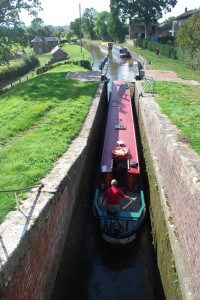 And finally, in the sixth photo Tom is now driving out of the lock. I’ve fudged this photo sequence a bit, as this photo was actually taken as Tom was driving out of the third lock in the stair case, and that’s why the lock walls seem so high.
And finally, in the sixth photo Tom is now driving out of the lock. I’ve fudged this photo sequence a bit, as this photo was actually taken as Tom was driving out of the third lock in the stair case, and that’s why the lock walls seem so high.
At this point, we’ve dropped down about 20’ in elevation, transited three locks, and it’s taken about ½ hour of time to do it. Tied up ahead of us are the boats waiting to be taken “up” to exit the Montgomery Canal. By 2PM the lockkeeper will have moved a dozen or so boats through the locks and she can go home for the day.
!
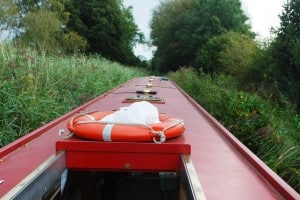 I did almost all of the driving as we headed south on the Montgomery Canal. As I mentioned earlier, this canal is much more primitive than we’d been used to up to this point, and the next photo really shows it – it’s almost as if the reeds and shrubs have grown in around us and we’re carving our way through it. In fact, there’s a definite waterway ahead, but you can’t see it from the angle of the photo. Nevertheless, the reeds and shrubs are brushing against us on both sides.
I did almost all of the driving as we headed south on the Montgomery Canal. As I mentioned earlier, this canal is much more primitive than we’d been used to up to this point, and the next photo really shows it – it’s almost as if the reeds and shrubs have grown in around us and we’re carving our way through it. In fact, there’s a definite waterway ahead, but you can’t see it from the angle of the photo. Nevertheless, the reeds and shrubs are brushing against us on both sides.
Our bigger problem with this cruise day was the fact that it’s Sunday, we’re in a pretty remote area, it’s getting late in the afternoon by the time we’ll be at our turnaround point, and we don’t know where we’re going to turn this 66’ boat around, much less moor it for the night, and have dinner somewhere. We obviously aren’t going to moor in an area such as we’re in when I snapped the above photo, and we definitely aren’t going to turn it around here. A final thing to think about is, we’d determined this would be a single overnight journey down the Montgomery Canal, so we’d have to be back at the Llangollen Canal junction in the morning, ready to go through the “up” locks in the 12 noon-2PM timeframe.
While I’m driving, Kap, Tom, and Linda are each poring over our various canal guide books and maps, trying to get a handle on all of this. First, being a Sunday, neither of the two pubs in the Maesbury Marsh area are open (one was, but it closed a few minutes before we got there) – so dinner for the night would be the steak/pork and ale pies that we’d bought a week earlier and are now sitting in the freezer. Linda also bought a few potatoes and a head of cauliflower, and was planning to show me how to make mashed cauliflower/potatoes.
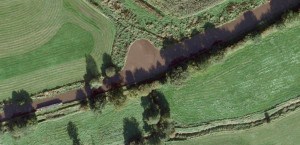 First up on the agenda was where to turn the boat around. Early in the cruise we’d noticed something on the canal maps called a “winding hole”. We’d puzzled over it at the time, and when we saw the first one it hit us – it’s a circular widening of the canal, designed to allow a narrowboat to turn around (there’s a Google Map of one at left). On our maps, each winding hole was indicated with a number – giving the turning radius of the hole, and therefore the boat length that can turn around there. For instance, if it said 60, that meant boats up to 60’ length would be able to turn around. The longest ones said 70, so that allowed for our 66’ boat. Well, the two ahead on our maps both said 70, so, Bob’s your uncle, we should be able to turn around in either.
First up on the agenda was where to turn the boat around. Early in the cruise we’d noticed something on the canal maps called a “winding hole”. We’d puzzled over it at the time, and when we saw the first one it hit us – it’s a circular widening of the canal, designed to allow a narrowboat to turn around (there’s a Google Map of one at left). On our maps, each winding hole was indicated with a number – giving the turning radius of the hole, and therefore the boat length that can turn around there. For instance, if it said 60, that meant boats up to 60’ length would be able to turn around. The longest ones said 70, so that allowed for our 66’ boat. Well, the two ahead on our maps both said 70, so, Bob’s your uncle, we should be able to turn around in either.
Being the conservative types, and after much discussion, we decided to turn around in the first of the two that we came to. When we got to it, Tom was driving, and I was next to him giving moral support, with Kap in the bow. Tom turned into the winding hole, but was maybe going a bit too fast for the sluggishness of the boat’s handling, and before we knew it, the bow hit one side of the hole, and the stern was tight up against a bunch of reeds along the side. Dang! This doesn’t look like 70’ at all. Kap was working a wooden pole (provided for just such a purpose) to help turn the bow, and Tom and I were trying to figure out how best to swing around in the reeds (all the while worried we’d get a bunch of reeds wound around the prop, and boy, would we be stuck!). Finally, we gave up after realizing the winding hole was no longer 70’, as reeds had grown into the winding hole. We continued south, with Tom handing over the tiller to smarty-pants me.
The next hole looked larger, and better still, it was clear of reeds along the bank. It looked to be a pushover. I slowly maneuvered into an arc to the right, calculating in my mind the best point for the bow to swing around, and hopefully we’d just pivot in place until we finished a 180° turn. Dang again! The boat just wouldn’t respond as I’d hoped, and before I knew it the bow was banging the shore, the stern was banging the other shore, and we were catawampus in the winding hole. At this point, the real steering problem with a narrowboat becomes evident – it can only back straight (i.e., you cannot steer the boat one way or the other while in reverse). It was all Kap and Tom could do with the wooden pole on the bank and the canal bottom to slowly swing our bow around and make the turn for us that way. The big embarrassment was, a guy came out of a house next to the winding hole just to watch our antics (although I’m sure he’s seen it plenty of times), not offering advice, and just letting us get out of our predicament on our own.
We finally reached our moorage point about 6PM, weary, and ready for a Happy Hour. The steak/pork pot pies were excellent, the mashed potatoes/cauliflower were absolutely wonderful, and we settled into a quiet night on the Montgomery Canal.
Tuesday, September 30, 2014, Maesbury March to Ellesmere. Next morning we headed back towards the Llangollen Canal, transited the five locks to get out, and we were on our way. The goal for the day was Ellesmere, where we really needed to get our black water tanks pumped out (actually, we didn’t know their status as there isn’t a gauge, but we didn’t want to find they were full at the moment they were full, if you get my drift). There was a marina at Ellesmere that had a pump out station and we were successful.
It was again my day to drive (Kap had been fighting a cold for several days, and she was definitely feeling under the weather – but starting to improve).
The overnight at Ellesmere was a good one, we ate at the same pub as before, had a morning latte at the only bakery we’d found so far that opened at an early hour, and we got our black water tanks pumped out before leaving.
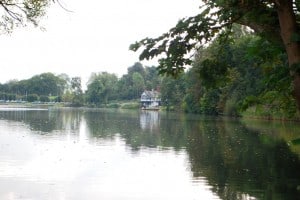 The best part of the day was finding a fresh water lake called Cole Mere along the canal and just a mile or so outside of Ellesmere (“mere” means lake in either Old English or Welsh, and it’s the reason for that suffix on town names). We pulled over to give it a closer look, and finding that it’s part of a national park and has a pathway leading all the way around it, we decided it was time to get off the boat for a couple of hours.
The best part of the day was finding a fresh water lake called Cole Mere along the canal and just a mile or so outside of Ellesmere (“mere” means lake in either Old English or Welsh, and it’s the reason for that suffix on town names). We pulled over to give it a closer look, and finding that it’s part of a national park and has a pathway leading all the way around it, we decided it was time to get off the boat for a couple of hours.
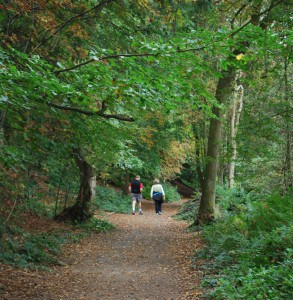 The walk around the lake was absolutely wonderful. the pathway was clear and well maintained, and it was a welcome change from being on the narrow boat. We only met a few people along the pathway, and most of them were walking their dogs.
The walk around the lake was absolutely wonderful. the pathway was clear and well maintained, and it was a welcome change from being on the narrow boat. We only met a few people along the pathway, and most of them were walking their dogs.
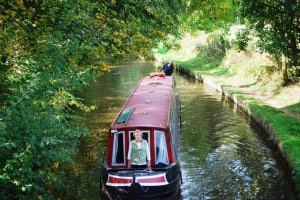 Our only “canal dunking” incident of the entire trip occurred as Linda was getting back on the boat after the walk. Tom and Kap stayed behind on the bridge we’d crossed to get to the lake – they wanted to take a photograph from the bridge as Linda and I brought the boat forward. I was loosening the stern line from the shore and Linda was loosening the bow line – and as she stepped onto the boat the foot on shore slipped, sending one foot into the drink. Luckily she had a good hand grasp on the boat or otherwise she’d have been in the muddy water for the full depth – all of 2-3’ or so.
Our only “canal dunking” incident of the entire trip occurred as Linda was getting back on the boat after the walk. Tom and Kap stayed behind on the bridge we’d crossed to get to the lake – they wanted to take a photograph from the bridge as Linda and I brought the boat forward. I was loosening the stern line from the shore and Linda was loosening the bow line – and as she stepped onto the boat the foot on shore slipped, sending one foot into the drink. Luckily she had a good hand grasp on the boat or otherwise she’d have been in the muddy water for the full depth – all of 2-3’ or so.
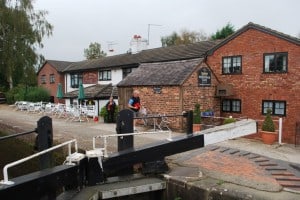 Our intended stop for lunch was at the Willey Moor Locks, where a pub of the same name stands no more than 10’ from the edge of the locks. It had been recommended to us on the way out, but the timing for a stop wasn’t right. We had a so-so lunch (all but Kap had a hamburger, as we were thoroughly tired of pub food), while Tom and Linda worked feverishly to change their flight reservations to London, moving them up by two days. After careful discussions, our decision was to turn the boat in two days early, so tonight would be our next to last night on the Yellow Legged Gull.
Our intended stop for lunch was at the Willey Moor Locks, where a pub of the same name stands no more than 10’ from the edge of the locks. It had been recommended to us on the way out, but the timing for a stop wasn’t right. We had a so-so lunch (all but Kap had a hamburger, as we were thoroughly tired of pub food), while Tom and Linda worked feverishly to change their flight reservations to London, moving them up by two days. After careful discussions, our decision was to turn the boat in two days early, so tonight would be our next to last night on the Yellow Legged Gull.
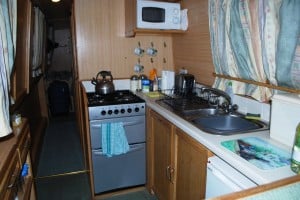 Our stop for the night was along the bank of the canal, with two well-groomed ponies grazing in a field opposite the canal from our moorage. We ate our last set of steak and ale pies for dinner and spent a long time talking about how the cruise had gone so far, and what we still had to do to turn the boat in. This was only our second dinner meal aboard the boat – primarily because we didn’t want for this to be a working cruise, but instead, just for fun, and secondarily, the galley wasn’t big enough to really do a lot of cooking. It was adequate
Our stop for the night was along the bank of the canal, with two well-groomed ponies grazing in a field opposite the canal from our moorage. We ate our last set of steak and ale pies for dinner and spent a long time talking about how the cruise had gone so far, and what we still had to do to turn the boat in. This was only our second dinner meal aboard the boat – primarily because we didn’t want for this to be a working cruise, but instead, just for fun, and secondarily, the galley wasn’t big enough to really do a lot of cooking. It was adequate
Lock hazards. At this point we’ve finished with our last lock of the trip, so maybe it’s a good time to mention the biggest lock hazard that kept us on our toes – hanging up on the sill during a “down” lock.
We’d been briefed on this on our pick-up day, and we fully understood the inherent dangers with the situation. What concerned me about it was, we didn’t have to worry about this for all of our lock transits for the first week – because they were all “up” lock transits. It’s only possible to do it on a down lock (which were all of the locks on our return week– so we’d have a week to forget the cautions).
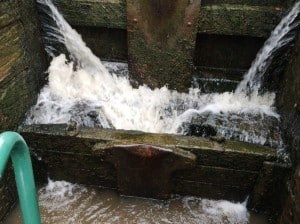 For reasons that were never clear to me, there’s a concrete/rock sill at the entrance-only end of each lock. When you enter the lock there’s always a caution written clearly in white paint that says, “Stay ahead of sill”, and when you see it for the first time going through a down lock, you can certainly see why. I snapped the accompanying photo of the sill – as it was just being exposed during one of our down lock transits on the return trip home, and I must say, it puts a fear into you. From that point on I paid even more attention to the boat’s movement in the lock as it was being drained, to ensure that we didn’t hang up on the sill.
For reasons that were never clear to me, there’s a concrete/rock sill at the entrance-only end of each lock. When you enter the lock there’s always a caution written clearly in white paint that says, “Stay ahead of sill”, and when you see it for the first time going through a down lock, you can certainly see why. I snapped the accompanying photo of the sill – as it was just being exposed during one of our down lock transits on the return trip home, and I must say, it puts a fear into you. From that point on I paid even more attention to the boat’s movement in the lock as it was being drained, to ensure that we didn’t hang up on the sill.
We’d seen a photo during our intro briefing of a boat from our same hire company being hung on the sill sometime in the past couple of years, and we just assumed the remedy (after you change your shorts from the horror of being on your boat as the nose goes down with the water, but not your stern) would be to simply do the reverse with the lock mechanism and refill the lock to refloat the boat. Apparently not.
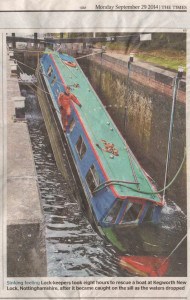 Yesterday while reading our daily Times over breakfast, we chanced upon the newspaper clipping that I’ve scanned in of a boat that hung up on the sill on a canal in Nottinghamshire. If you note the caption, it took eight hours to get this boat refloated – and during that entire eight hours the lock was out of commission, with narrowboats backing up on either side of the lock. It must have been a royal mess! As we later learned (and as you can see in the photo), the boat’s nose is well under water, and the lock is at minimum water with the canal going out from it (so there is no way to get water level any lower). When they tried to refloat it, the water in the nose kept the boat submerged. How they managed the refloat isn’t explained, and in thinking it all over, we have no idea what they actually did to refloat this boat. (Of course, they could always bring in a heavy crane to lift it out, but the lock was probably quite remote, and who knows what it would take to get a mobile crane into a location like this.)
Yesterday while reading our daily Times over breakfast, we chanced upon the newspaper clipping that I’ve scanned in of a boat that hung up on the sill on a canal in Nottinghamshire. If you note the caption, it took eight hours to get this boat refloated – and during that entire eight hours the lock was out of commission, with narrowboats backing up on either side of the lock. It must have been a royal mess! As we later learned (and as you can see in the photo), the boat’s nose is well under water, and the lock is at minimum water with the canal going out from it (so there is no way to get water level any lower). When they tried to refloat it, the water in the nose kept the boat submerged. How they managed the refloat isn’t explained, and in thinking it all over, we have no idea what they actually did to refloat this boat. (Of course, they could always bring in a heavy crane to lift it out, but the lock was probably quite remote, and who knows what it would take to get a mobile crane into a location like this.)
Since this photo in The Times occurred just as we were finishing up our series of down locks, we knew exactly what the hapless boat renters (plus the boat hire company, plus everyone else trying to get through the locks) must have been going through.
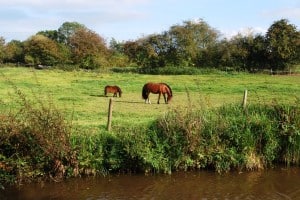 Wednesday, October 1, 2014, Alongside The Horse Pasture to Wrenbury Mill. It’s our last full day aboard the Yellow Legged Gull – and less than 10 miles to get back to our starting point. Tom and Linda have changed their flight and hotel reservations to Thursday (tomorrow), flying from Manchester (about 35 miles north of Wrenbury Mill) to London’s Heathrow, so the plan is to tie up for the night just before the lift bridge at the boat hire basin, then return the boat on Thursday morning in time for them to catch a taxi to Manchester Airport. It’s two days earlier than our required return date, but we’ve seen and done all we came for, so why not make an end of it now.
Wednesday, October 1, 2014, Alongside The Horse Pasture to Wrenbury Mill. It’s our last full day aboard the Yellow Legged Gull – and less than 10 miles to get back to our starting point. Tom and Linda have changed their flight and hotel reservations to Thursday (tomorrow), flying from Manchester (about 35 miles north of Wrenbury Mill) to London’s Heathrow, so the plan is to tie up for the night just before the lift bridge at the boat hire basin, then return the boat on Thursday morning in time for them to catch a taxi to Manchester Airport. It’s two days earlier than our required return date, but we’ve seen and done all we came for, so why not make an end of it now.
Kap and I have decided to spend our extra two days driving down to Cardiff, the capitol city of Wales. We’ll then head over to London on Saturday to turn in our car as planned, and spend the remaining four days checking out our old haunts in London. The return date to the U.S. for Tom and Linda is Monday, the 6th, and for Kap and me it’s Wednesday, the 8th.
From here it was all downhill, literally and figuratively. By mid-afternoon, with Kap walking ahead to scout out a mooring spot, we pulled into the moorage area just before the Wrenbury Mill lift bridge and secured the Yellow Legged Gull for the final time. We had our last pub meal at the Dusty Miller Pub, directly across the canal from our boat basin turn-in tomorrow morning, and the evening was spent packing our luggage for the morning’s departure.
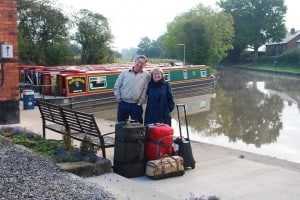 Thursday, October 2, 2014, Wrenbury Mill and Turn-In. The boat basin opens its doors at 8:30AM, and we were there bright and early to request assistance in getting our narrowboat into the basin (a tricky 90° backing in to a stern tie alongside the other boats in the basin). I got the honor of driving the Yellow Legged Gull through one last lift bridge – an overall distance of maybe 200 yards – and our 2014 Narrowboat Cruise of the Llangollen Canal was over.
Thursday, October 2, 2014, Wrenbury Mill and Turn-In. The boat basin opens its doors at 8:30AM, and we were there bright and early to request assistance in getting our narrowboat into the basin (a tricky 90° backing in to a stern tie alongside the other boats in the basin). I got the honor of driving the Yellow Legged Gull through one last lift bridge – an overall distance of maybe 200 yards – and our 2014 Narrowboat Cruise of the Llangollen Canal was over.
——————————————————————————————————————–
Epilogue to our cruise. As I write this we’re back home and getting settled. A couple of questions and comments about doing a U.K or Continental canal cruise.
First, would we do this again? Without doubt, in a heartbeat. A caveat, though, is that we’d like to explore a bit more upscale narrowboats for hire. The company we rented from on this cruise was great – Blue Water Holidays, and their primary narrowboat site that we used is at http://www.canalholidays.com/llangollen-canal.htm. All of the people there were absolutely superb, but our boat was a bit less than we’d have liked (sort of “ridden hard and put away wet”. For future trips we might explore web sites where we can see a bit more in advance exactly what our boat will look like, what the inside quality is like, and how well it’s been maintained.
Second, is this affordable? Surprisingly so! We paid US$4,175 for a 14-day cruise, and split between two couples that works out to US$150/day. It’s hard to find a hotel/motel anywhere for this price, and to add on all of the fun on top of that . . . it’s just unbeatable.
Third, is boating experience required for this? No! The boat hire companies are happy to provide as much training as they feel you need before you leave the dock. In our case, our guy jumped off after riding with us for a quarter mile. Having said that, on our final cruising day, we met a private boat and the guy driving it hollered across to us as we passed, “watch out, around the corner ahead of you is a boat that was just picked up, and they’re using both sides of the canal. We joked back and waved, and it wasn’t until we saw them coming that we realized just how true his statement was. As we rounded the corner I could see the driver ahead swinging the tiller wildly and it gave us pause for concern when he aimed his boat right at us. At the last minute he managed to get his boat turned back the other direction and narrowly missed us as he went by (and going too fast for his level of experience). Behind us, he indeed swerved from bank to bank as he continued to wildly swing the tiller. So, no boating experience is required, but there are definitely people out there who shouldn’t be driving these things, even if they’re only going 2-4 MPH. My guess is, by the time this driver went much further, he’d figured out the steering of his boat and probably had a good (and safe) time.
Fourth, how about cruising in other European countries? As I mentioned, we’ve already done a canal cruise in France, and I doubt we’d do that again. On the Canal du Midi that we cruised in 2009, they set the toilets to go overboard, rather than use the black water tanks that each boat has. Why they do this is a total mystery to us, as it means you’re basically flushing sewage from every boat right into the canal – and it’s a canal used by thousands of boats, and given how shallow the canals are, this sewage is terribly concentrated. Knowing about this, we used rubber gloves to handle anything/everything that might come in contact with the water. But, on the other hand, we’d probably try the canals in The Netherlands or Germany without hesitation!
